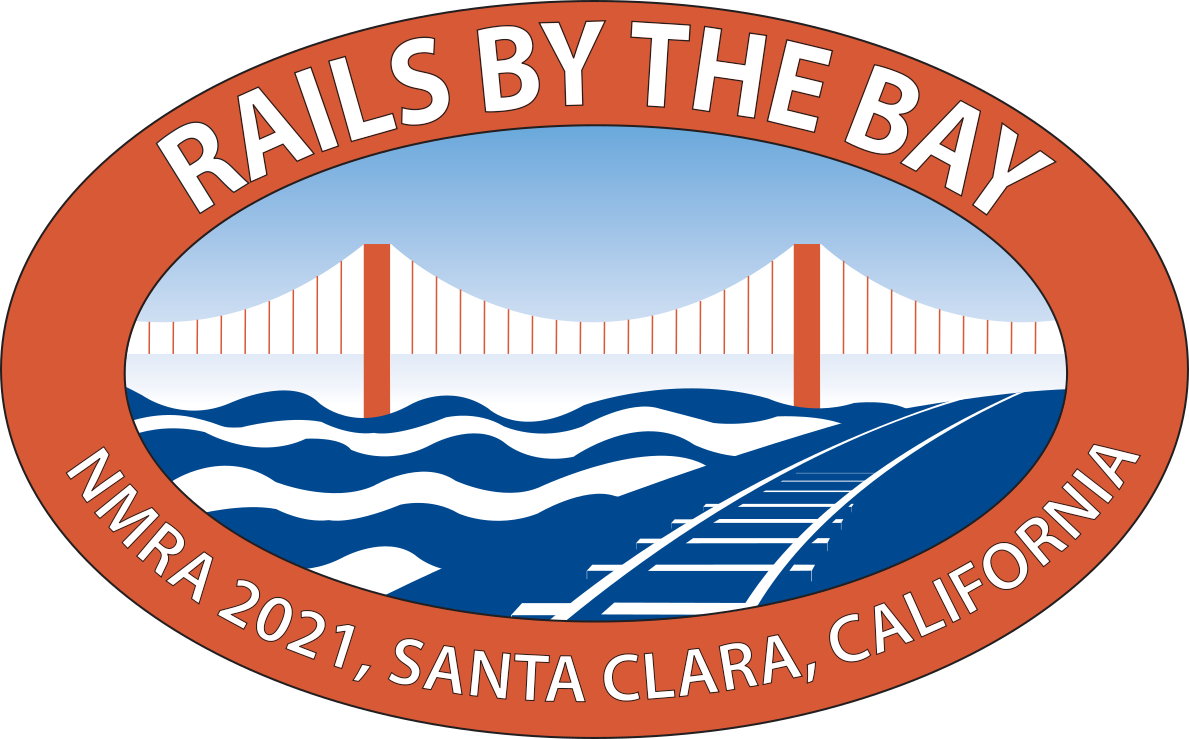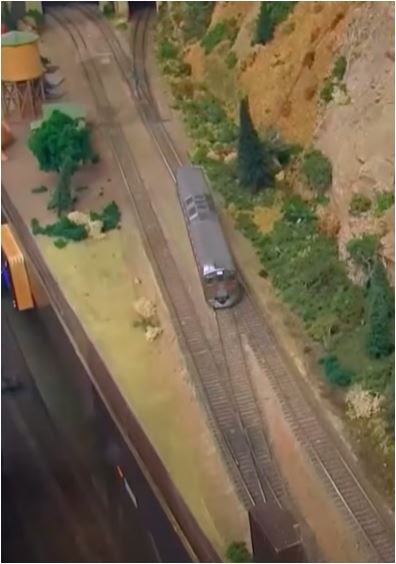Layout Tours
Coordinator
Paul Deis
Due to Rails by the Bay being virtual, we will have online video layout tours of the finest layouts in the San Francisco Bay Area for your viewing pleasure with no driving or long bus rides! The Bay Area is home to many premier world-class model railroads you've been reading about in the model railroad press for years. Click the layout name below to view the video layout tour.
Layout Owner Panels (Q&A Sessions)
In addition to the video layout tours, we also have scheduled live moderated Layout Owner Panels with some of the layout owners where you will be able to ask them questions and learn from them. We recommend watching their layout videos before the convention so you can avail yourself of this opportunity.
Video Layout Tours
Here's the current (as of ) list of layouts that have online videos to whet your appetite for what is to come July 6th. We recommend watching the layout tour videos before the convention and then use that knowledge and familiarity with the layouts during the Layout Owner Panels and in the breakouts to talk to the layout owners about their experiences building, maintaining, and operating their layouts.
Layout Tour Videos, except when noted otherwise, used with permission of John Abatecola, TSG Multimedia. Thank you!
| James B. Vail, MMR® — A Memorial HOn3 |
| Glenwood & Black Creek Railroad |
A Tribute to Jim Vail • Wednesday, 7:00 – 8:00 PM • Zephyr Track, with long-time G&BCR operators Guy Cantwell, Craig Symington, Jerry Boudreaux, and Dave Adamse, Moderator.
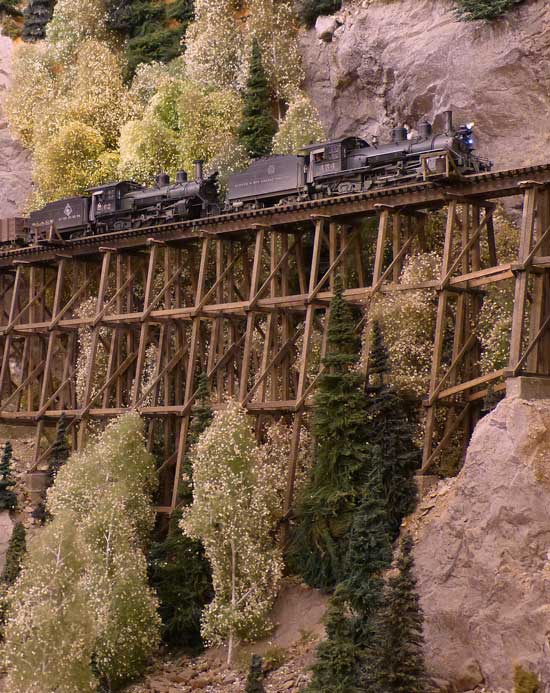 Though the Glenwood & Black Creek Narrow Gauge Railroad is a fallen flag, it is not forgotten. Jim Vail used his railroad as the basis for most of the 174 articles published in the Narrow Gauge and Short Line Gazette magazine, as well as articles he authored for other model railroad publications. Those articles covered the construction and continuous expansion of the HOn3 empire in his basement.
Though the Glenwood & Black Creek Narrow Gauge Railroad is a fallen flag, it is not forgotten. Jim Vail used his railroad as the basis for most of the 174 articles published in the Narrow Gauge and Short Line Gazette magazine, as well as articles he authored for other model railroad publications. Those articles covered the construction and continuous expansion of the HOn3 empire in his basement.
The railroad started as a series of self-contained modules which were later integrated into the design of a new railroad for a basement in a new home. Jim was a prolific builder and the original design included hooks for expansion, all of which were eventually used, and then Jim devised other ways to keep the expansion going. This included removing a bathroom and filling that space with three different scenes that tied back into the railroad in different locations. This same creativity resulted in double-deck staging yards in an area of the basement that was never to be used for the model railroad.
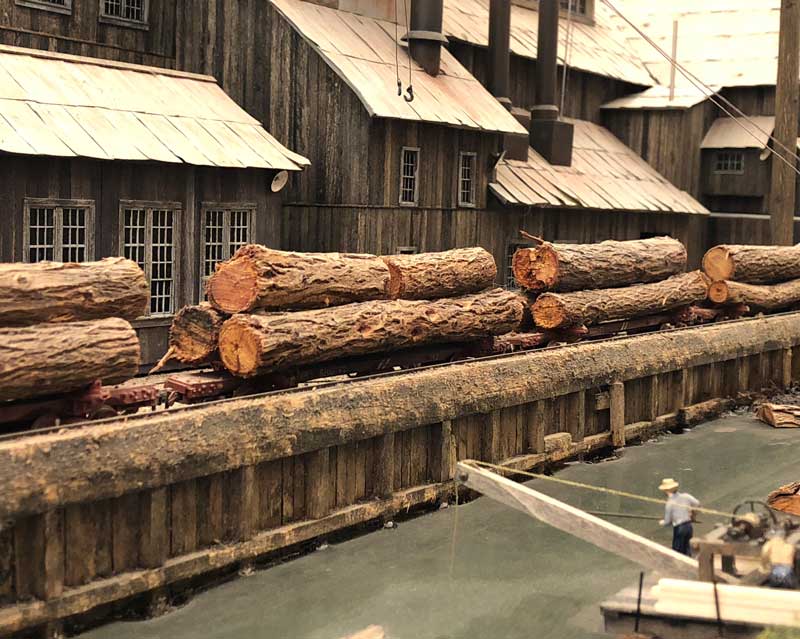 Jim said he drew inspiration from John Allen’s game changing HO Gorre & Daphetid Railroad, and was privileged to visit John and his railroad on several occasions. John’s influence on Jim is evident to anyone who had the pleasure of visiting Jim’s railroad. If John Allen is known as the "Wizard of Monterey", then Jim Vail is certainly the "Sorcerer of Santa Cruz."
Jim said he drew inspiration from John Allen’s game changing HO Gorre & Daphetid Railroad, and was privileged to visit John and his railroad on several occasions. John’s influence on Jim is evident to anyone who had the pleasure of visiting Jim’s railroad. If John Allen is known as the "Wizard of Monterey", then Jim Vail is certainly the "Sorcerer of Santa Cruz."
Jim loved building scenery, structures, rolling stock, automobiles, and machinery to create detailed scenes that would draw you in so you thought you saw everything, only to discover on the next visit you had missed half of it. The crew that was tasked with removing this marvelous railroad were amazed at how many things they collectively had not seen over the years.
 Control systems went from tethered DC with fixed cabs, to radio control throttles made from model aircraft RC controls, to commercial model railroad IR controls, to a combination of IR and radio controls tied to DC sound systems, and finally DCC when small sound steam decoders arrived on the market.
A billboard on the layout advertised the G&BC to citizens of the layout and it included the tagline “Big Then and Bigger Now” which certainly was true.
Control systems went from tethered DC with fixed cabs, to radio control throttles made from model aircraft RC controls, to commercial model railroad IR controls, to a combination of IR and radio controls tied to DC sound systems, and finally DCC when small sound steam decoders arrived on the market.
A billboard on the layout advertised the G&BC to citizens of the layout and it included the tagline “Big Then and Bigger Now” which certainly was true.
Enjoy the TSG Multimedia video made before the Glenwood & Black Creek was dismantled and attend the live panel discussion to learn more about this iconic HOn3 railroad and its builder.
Written by Dave Adams, Glenwood & Black Creek Operator
| Alameda County Central Railroad Society HO/O |
| HO Scale Layout • O Scale Layout |
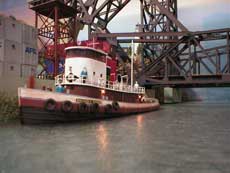 ACCRS or "the Pleasanton Club" is located on the Alameda County Fairgrounds in a 100' x 35' building. The club has two layouts separated by a central viewing aisle allowing viewing of both the O scale and HO scale layouts simultaneously. Both scales are designed to operate either with analog or NCE DCC control. The O scale layout has standard gauge, narrow gauge and trolley operations. The standard gauge only HO layout includes an operating thunderstorm, a drive-in movie, and a port with a 3 foot long scratch built container ship.
ACCRS or "the Pleasanton Club" is located on the Alameda County Fairgrounds in a 100' x 35' building. The club has two layouts separated by a central viewing aisle allowing viewing of both the O scale and HO scale layouts simultaneously. Both scales are designed to operate either with analog or NCE DCC control. The O scale layout has standard gauge, narrow gauge and trolley operations. The standard gauge only HO layout includes an operating thunderstorm, a drive-in movie, and a port with a 3 foot long scratch built container ship.
Website: accrs.org
Back to QwikLinks| Dave Adams | On3 |
| Denver & Rio Grande Western Durlin Branch | |
| LDSIG Recommended Layout | |
Layout Owner Panel • Tuesday, 7:00 – 8:00 PM • Zephyr Track
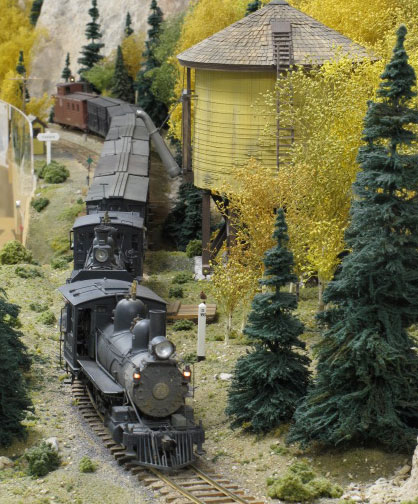 This railroad is a freelanced two-headed branch line out of Chama, New Mexico on the D&RGW’s Fourth Division narrow gauge line. Durlin is one of the branch terminals, with industries representative of those in Silverton, Colorado, and Flint is the other branch terminal serving a coal mine based on the big CF&I breaker at Floresta, Colorado. Durango, and other points west of Chama are represented by staging, as is Alamosa and other points east of Chama. Prototype scenes include Chama, Cresco, Toltec Tunnel, and Navajo.
This railroad is a freelanced two-headed branch line out of Chama, New Mexico on the D&RGW’s Fourth Division narrow gauge line. Durlin is one of the branch terminals, with industries representative of those in Silverton, Colorado, and Flint is the other branch terminal serving a coal mine based on the big CF&I breaker at Floresta, Colorado. Durango, and other points west of Chama are represented by staging, as is Alamosa and other points east of Chama. Prototype scenes include Chama, Cresco, Toltec Tunnel, and Navajo.
An 18' x 27' room houses the layout which is a partial double-deck design. Trackwork is 100% complete, the scenery is 96% complete and only one major structure remains to be built (meanwhile the foam core mock-up works fine). 97% of the rolling stock is kit or scratch built, steam locomotives are primarily brass which have all been remotored/regeared/detailed/painted with primarily Soundtraxx decoders installed. Locomotive control is a CVP Easy DCC system with CVP wireless Ops throttles.
Articles in Model Railroader, January 2000, Finescale Railroader, Narrow Gauge Annual 2003, Model Railroad Hobbyist, April 2011, and most recently Narrow Gauge & Short Line Gazette, March/April 2021.
More photos and information on the BayRails website.
Back to QwikLinks| Bay Area Z Scalers | Z |
| The BAZ BoyZ Modular Layout | |
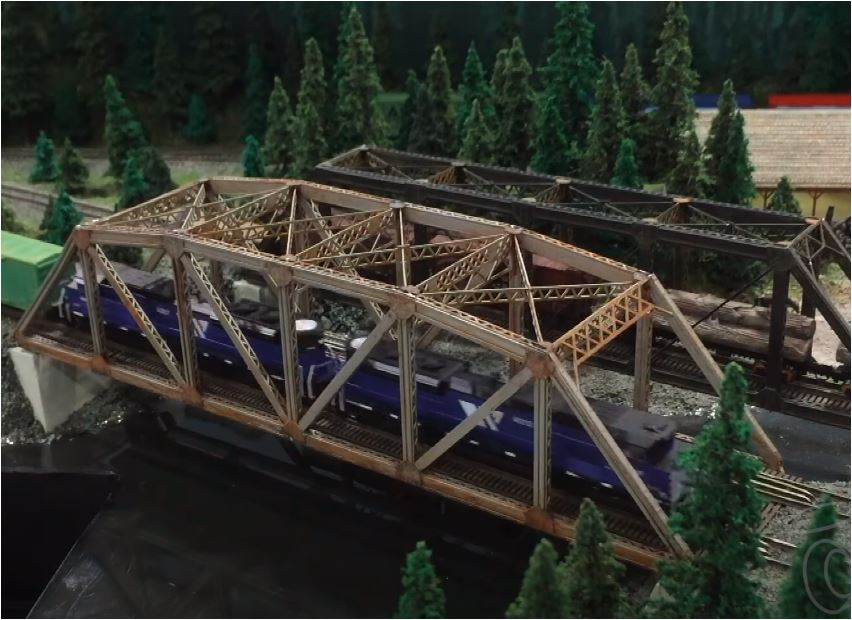 This layout tour video is from The Great Train Show in San Jose, California, on February 26, 2017. The Great Train Show features all kinds of railroad-related memorabilia, as well as several modular layouts. Several of the modules in the layout are award winners, and you will be able to see why in this video.
This layout tour video is from The Great Train Show in San Jose, California, on February 26, 2017. The Great Train Show features all kinds of railroad-related memorabilia, as well as several modular layouts. Several of the modules in the layout are award winners, and you will be able to see why in this video.
Come along as we take a look at the San Francisco Bay Area Z Scale "BAZ BoyZ" modular layout. Good things do indeed come in small packages!
Back to QwikLinks| Robert Bowdidge | HO |
| Southern Pacific Vasona Branch | |
| LDSIG Recommended Layout | |
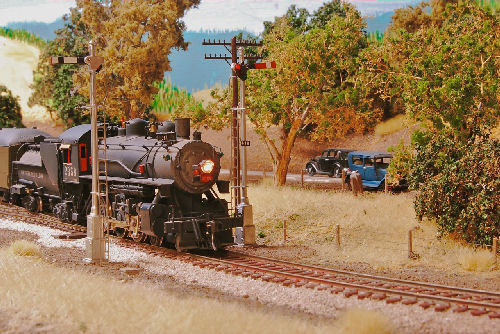 The layout is a two deck 10' by 14' HO layout in half of a two car garage. Track is complete. Most rough scenery and some finished scenery is in.
The layout is a two deck 10' by 14' HO layout in half of a two car garage. Track is complete. Most rough scenery and some finished scenery is in.
Operation focuses on switching the canneries, packing houses, and other industries in the valley; commute trains and freights heading to Santa Cruz also run to add additional traffic. A pair of two-man crews do heavy switching during the session.
Layout control is via EasyDCC wired throttles. Most locomotives are sound-equipped; all locomotives are the small steam engines seen on the actual branch. Much of the layout runs in "yard limits", but signals and informal dispatching control the track over the hill (as on the prototype); a 2:1 fast clock sets the pace of the session. Switching is done from switch lists.
Featured in the November 2020 issue of NMRA Magazine.
More photos and information on the BayRails website.
Website: www.vasonabranch.com/railroad/vasona.html
Back to QwikLinks| Jack Burgess, MMR® | HO |
| Yosemite Valley Railroad | |
| LDSIG Recommended Layout | |
Layout Owner Panel • Friday, 7:00 – 8:00 PM • Zephyr Track
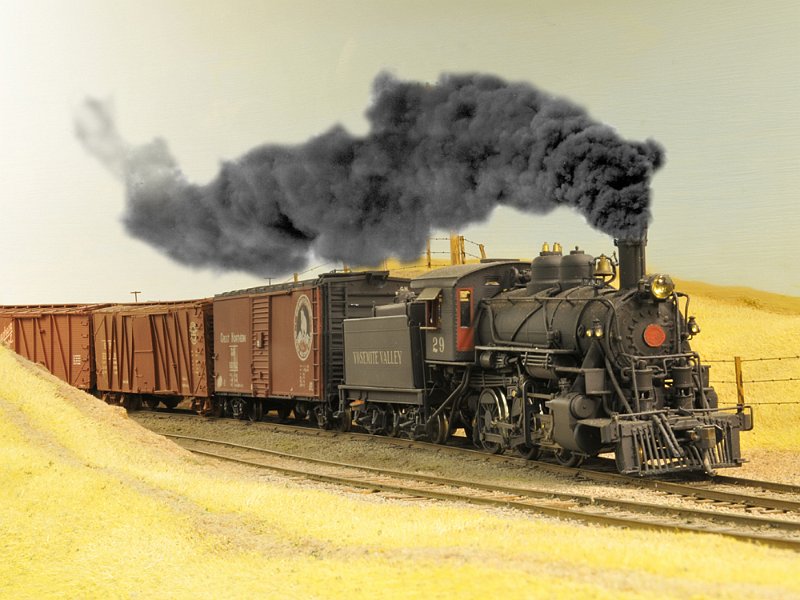 The layout duplicates the prototype Yosemite Valley Railroad in August 1939. The layout features handlaid track and turnouts with slow-action motors (some with working switchstands) and NCE radio-controlled DCC throttles with SoundTraxx decoders in all locomotives. All of the locomotives and equipment are correct for 1939. Scenery is 100% complete and duplicates prototype topography and vegetation. There are approximately 100 scratch-built structures on the layout, all of which duplicate actual buildings on the prototype. Rolling stock is a combination of scratch-built models and prototypically-correct resin and styrene kits. Operation is via TT/TO using prototype-based forms.
The layout duplicates the prototype Yosemite Valley Railroad in August 1939. The layout features handlaid track and turnouts with slow-action motors (some with working switchstands) and NCE radio-controlled DCC throttles with SoundTraxx decoders in all locomotives. All of the locomotives and equipment are correct for 1939. Scenery is 100% complete and duplicates prototype topography and vegetation. There are approximately 100 scratch-built structures on the layout, all of which duplicate actual buildings on the prototype. Rolling stock is a combination of scratch-built models and prototypically-correct resin and styrene kits. Operation is via TT/TO using prototype-based forms.
The operating style is prototypical, and tightly structured reflecting 1939 practices, i.e., little or no non-prototype talking, etc. On the other hand, the prototype involved a lot of waiting so, while the fast clock ratio is high, there is plenty of time for switching and getting the job done. Operations include 2 through freights and two locals operating at scale speeds (typically 15 mph) involving several meets.
Train control is by North Coast DCC with wireless throttles and Soundtraxx decoders, party-line telephone, TT&TO, 8:1 fast clock, switchlists, documentation includes employee timetable, fascia labeling, and orientation.
Jack's Yosemite Valley Railroad has been featured in numerous magazine articles. The most recent article is in the April issue of Railroad Model Craftsman.
Website: yosemitevalleyrr.com
More photos and information on the BayRails website.
Back to QwikLinks| California Central Club | HO |
| California Central Lines | |
Layout Owner Panel • Thursday, 7:00 – 8:00 PM • Zephyr Track
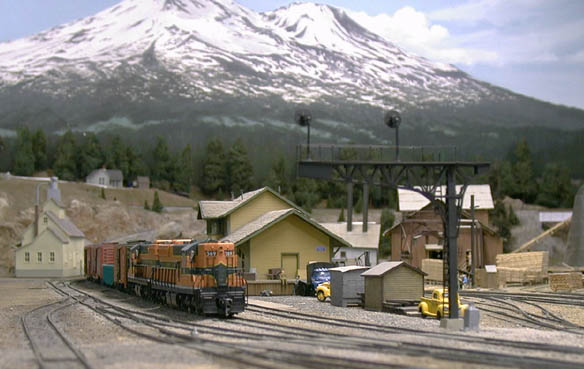 An HO and HOn3 club layout located in the historic Agnew Depot, built for the narrow gauge South Pacific Coast Railroad in 1877. Transition-era operations includes both steam and diesel, and dispatching is done differently according to the era.
An HO and HOn3 club layout located in the historic Agnew Depot, built for the narrow gauge South Pacific Coast Railroad in 1877. Transition-era operations includes both steam and diesel, and dispatching is done differently according to the era.
The 1,000 feet of double-track mainline represents California connections to the Pacific Northwest, Southeast, and East. Fully scenicked with backdrops painted by Mike Kotowski. There is a small dual-gauge branchline. The layout has been featured in Model Railroader and Railroad Model Craftsman.
Website: calcentralmrc.org
Back to QwikLinks| Guy Cantwell | HO |
| Willoughby Line | |
| LDSIG Recommended Layout | |
Layout Owner Panel • Friday, 7:00 – 8:00 PM • Zephyr Track
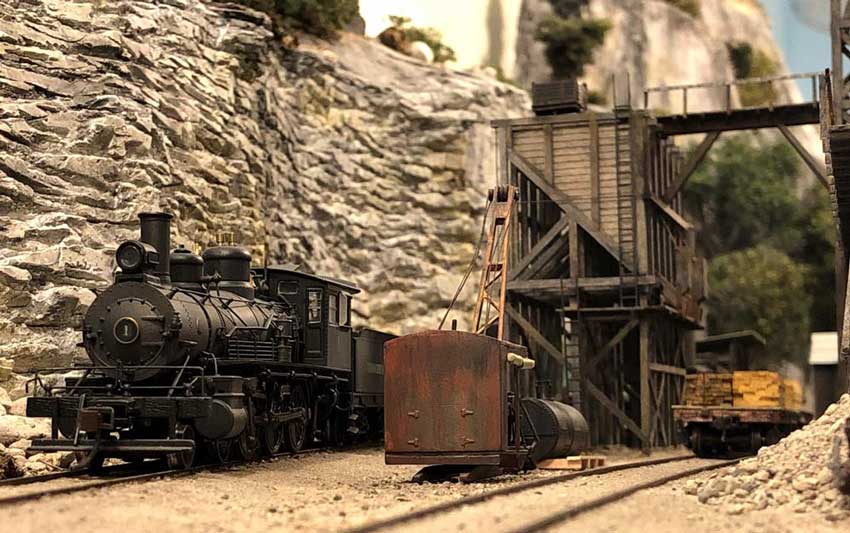 Double-deck proto-lanced railroad depicting West Coast steam in the 1950s. Scenes along the line are taken from the Sierra, Southern Pacific, Western Pacific, Hetch Hetchy, and Yosemite Valley railroads. Operations based track plan with inventive staging and helix design. Layout features lots of superdetailed and weathered rolling stock. Hardshell is 80% complete, overall scenery completion is 40%. Duckunder at 60”. Control is by CVP DCC.
Double-deck proto-lanced railroad depicting West Coast steam in the 1950s. Scenes along the line are taken from the Sierra, Southern Pacific, Western Pacific, Hetch Hetchy, and Yosemite Valley railroads. Operations based track plan with inventive staging and helix design. Layout features lots of superdetailed and weathered rolling stock. Hardshell is 80% complete, overall scenery completion is 40%. Duckunder at 60”. Control is by CVP DCC.
Website: thewilloughbyline.com/
Back to QwikLinks| Carquinez Model Railroad Society | HO |
| Crockett Central Railroad (Updated 6/22/21) | |
Layout Owner Panel • Tuesday, 7:00 – 8:00 PM • Zephyr Track
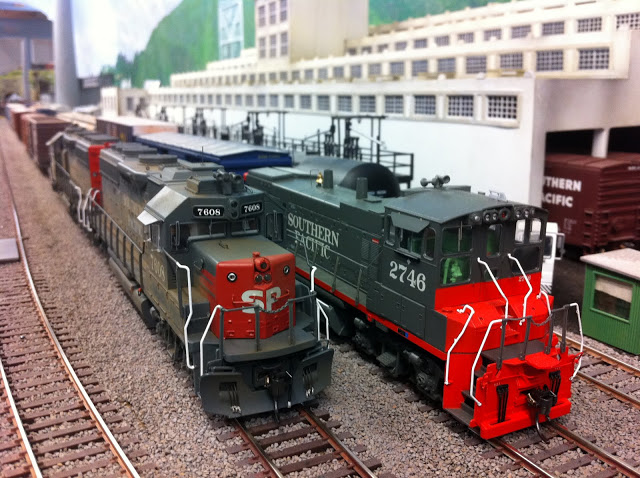 This HO layout loosely models the area from Oakland, California to Sparks, Nevada, which is a segment of the route of the old Southern Pacific Railroad portion of the original Transcontinental Railroad. The timeframe is from the 1950s to the present, thus allowing both steam and diesel locomotives to be operated.
This HO layout loosely models the area from Oakland, California to Sparks, Nevada, which is a segment of the route of the old Southern Pacific Railroad portion of the original Transcontinental Railroad. The timeframe is from the 1950s to the present, thus allowing both steam and diesel locomotives to be operated.
The majority of the layout is a double-track mainline, constructed in three levels with two large helixes on opposite corners of the layout to provide a connection between levels. The layout is a “mushroom-style” with a narrow, but long tabletop space that is stacked like bunk beds. An elevated walkway allows access to the top level. This design provides the most linear track space without having the tracks unrealistically twist back and forth. Code 100 track is used on the 1st level and helixes only, and code 83 track is used on the rest of the layout. The nominal minimum track radius is 48 inches. Maximum 2% grade is found on the helixes.
Website: cmrstrainclub.org/
Back to QwikLinks| Paul Claffey | Sn3 |
| Lost Creek Lumber Company |
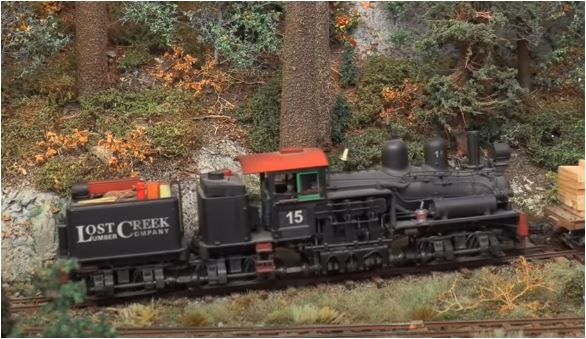 Paul Claffey's Lost Creek bi-level layout was built over the course of about thirteen years. The top deck has scenery around two thirds of it, and it's amazing. This freelanced layout was built for operations.
Paul Claffey's Lost Creek bi-level layout was built over the course of about thirteen years. The top deck has scenery around two thirds of it, and it's amazing. This freelanced layout was built for operations.
Paul gives us a look at what operations on his layout are like over the finished portion of the layout, then gives us a brief look at the rest of the unfinished parts. Paul's attention to detail and scratch-building skills are sure to impress even the pickiest modelers.
Join us for a tour of this layout, as it was scheduled to be dismantled within weeks after the video was made.
Back to QwikLinks| Mike Coen | HO |
| Western Pacific Oregon Division |
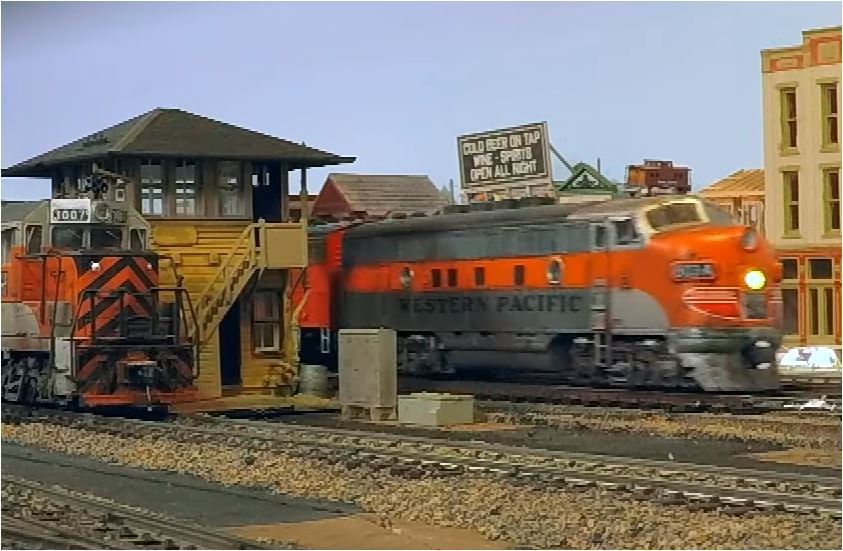 Proto-freelanced 1970s era. WP from Eugene, OR to Klamath Falls, OR. Heavy mainline, WP w/SP trackage rights, BN, Santa Fe run through trains. 280 ft. double decked mainline in an L-shaped, 22' X 34' room. Track-work 90% complete, scenery 10% complete with some structures. Track Warrants Operations. Car Cards and Way Bills control car forwarding. NCE wireless DCC.
Proto-freelanced 1970s era. WP from Eugene, OR to Klamath Falls, OR. Heavy mainline, WP w/SP trackage rights, BN, Santa Fe run through trains. 280 ft. double decked mainline in an L-shaped, 22' X 34' room. Track-work 90% complete, scenery 10% complete with some structures. Track Warrants Operations. Car Cards and Way Bills control car forwarding. NCE wireless DCC.
| Dave Connery, MMR® | HO/HOn3 |
| Sierra, Carson & Truckee Railway | |
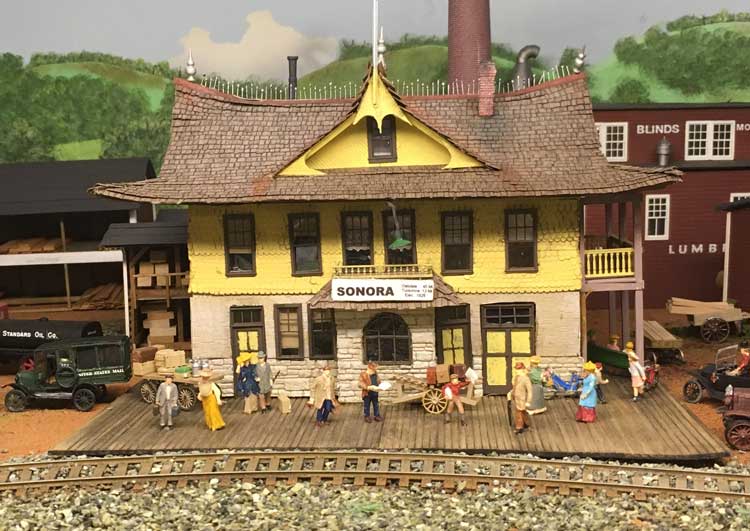 The SC&T is a two-level 10' x 17' layout (Virginia & Truckee on the upper level and Sierra Rwy. on the lower level) connected by helixes. Interchanges with HOn3 West Side Lumber Co.(lower level) and Carson & Colorado (upper level). All of this is in half of a single car garage.The scenery is basically complete. All prototype equipment is appropriate for 1929 with numerous scratch-built prototype structures.
The SC&T is a two-level 10' x 17' layout (Virginia & Truckee on the upper level and Sierra Rwy. on the lower level) connected by helixes. Interchanges with HOn3 West Side Lumber Co.(lower level) and Carson & Colorado (upper level). All of this is in half of a single car garage.The scenery is basically complete. All prototype equipment is appropriate for 1929 with numerous scratch-built prototype structures.
Dave's layouts have been featured in Railroad Model Craftsman, May 2000, and Model Railroader, May 2004.
P.S. The layout was dismantled shortly after the TSG video was completed.
Back to QwikLinks| Jim Dias | HO |
| Western Pacific 1938 | |
| LDSIG Recommended Layout | |
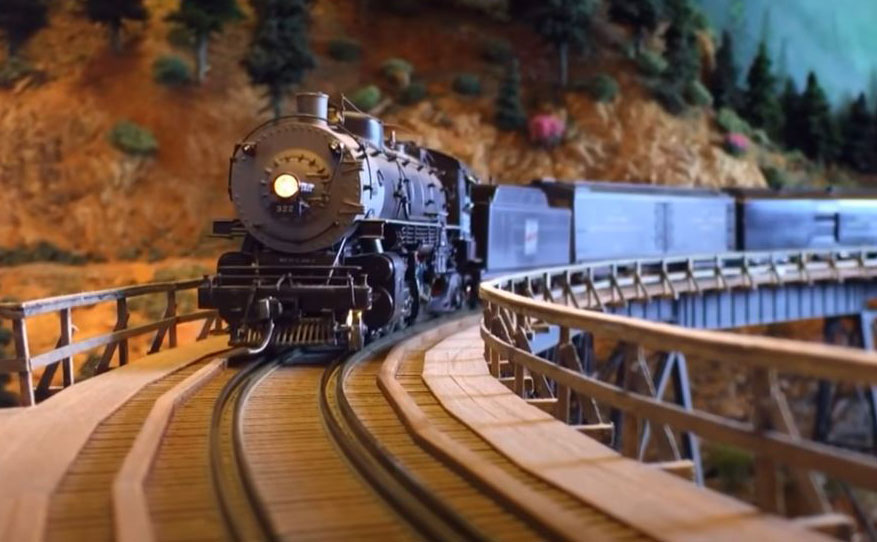 A beautiful re-creation in HO scale of the Western Pacific RR in the Spring of 1938. The area of the WP modeled is along the Feather River, including the Keddie Wye and a small logging area. The fidelity to prototype of the scenery has been praised by former WP employees, who readily recognize the scenes.
A beautiful re-creation in HO scale of the Western Pacific RR in the Spring of 1938. The area of the WP modeled is along the Feather River, including the Keddie Wye and a small logging area. The fidelity to prototype of the scenery has been praised by former WP employees, who readily recognize the scenes.
An interesting touch is the many sound modules included in the many detailed scenes. The layout has been featured in Railroad Model Craftsman June 1996, July 2000, March 2011, Railmodel Journal May 2000, Model Railroader September 2001 and Model Railroad Hobbyist May-June 2010.
System One/NCE DCC control (many locos are sound-equipped), pre-prepared switchlists, sequence timetable, verbal communications, no formal Dispatcher role, written instructional handouts for each job includes layout schematic.
More photos and information on the BayRails website.
Back to QwikLinks| Dick & Niles | HO |
| Southern Pacific Donner Pass Route This video was made available to convention attendees during the convention by special arrangement. It will be available to the public on September 11 at the TSG Multimedia YouTube Channel. |
|
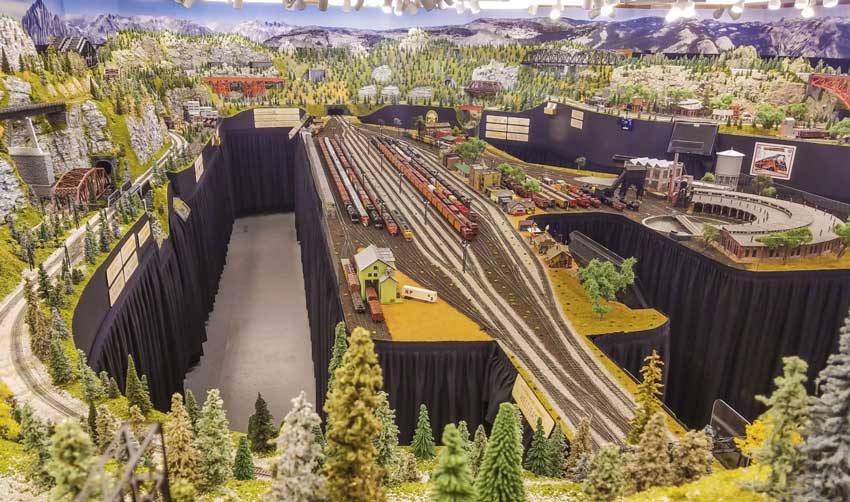 This layout models the Southern Pacific Overland Route across Donner Pass from Roseville to Sparks in the 1948 timeframe. The layout includes the towns of Roseville, Colfax, Blue Canyon, Emigrant Gap, Norden, Truckee, Boca, and Sparks. There is a 600’ dual mainline going over Donner Pass with a 1.5% ruling grade taking the trains from a 50” elevation to a 78” elevation. Auto staging is achieved by sharing double-ended hidden yards in Oakland and Ogden. Being a true mountain RR, there are no helixes or shelving. The layout is 34’ x 45’ with a “walk under” bridge entering the Roseville/Sparks Main Yard area and an elevated walkway around the back of the room to accommodate operations. Tunnels consume 27% of the mainline and there are 30 bridges on the layout.
This layout models the Southern Pacific Overland Route across Donner Pass from Roseville to Sparks in the 1948 timeframe. The layout includes the towns of Roseville, Colfax, Blue Canyon, Emigrant Gap, Norden, Truckee, Boca, and Sparks. There is a 600’ dual mainline going over Donner Pass with a 1.5% ruling grade taking the trains from a 50” elevation to a 78” elevation. Auto staging is achieved by sharing double-ended hidden yards in Oakland and Ogden. Being a true mountain RR, there are no helixes or shelving. The layout is 34’ x 45’ with a “walk under” bridge entering the Roseville/Sparks Main Yard area and an elevated walkway around the back of the room to accommodate operations. Tunnels consume 27% of the mainline and there are 30 bridges on the layout.
The layout is controlled by a computer station running Railroad and Co. TrainController software. Connected to the computer are 12 touch screens that display/control the signals, turnouts, and block occupancy. The computer tracks engine numbers on the touch screen block icons as engines move around the layout. CTC signal aspects are automatically generated based on turnout states and block occupancy. Connected to the computer is an NCE DCC system that provides track power. Cellphone throttles control the engines using a router connected to the computer.
Scheduled train operations follow a 1948 SP timetable using a 6X fast clock. Unscheduled way freights use car cards to manage their operation. Turnouts/routes are controlled by the Mountain Dispatcher and the Yardmaster. Operators maintain radio communication with the Dispatcher and Yardmaster. Operations consist of both EB and WB train movements with helpers cut in for Fruit Block trains from Colfax to Norden. Scheduling accommodates First Class trains passing slow freight trains as they navigate up the mountain.
The layout has been under construction for 20 years, with almost all the scenery completed in just the last year. In 2008, Dave Frary, Bob Hayden, and Scott Mason spent a week constructing the scenery in the Truckee area that taught us the basics to complete the scenery a decade later. The main scenery features of the layout are the massive 18-track wide mainyard surrounded by the Sierra Mountains, Donner Peak with snow sheds and the China Wall, and over 120’ of actual Sierra Mountain photograph backdrops surrounding the layout.
Back to QwikLinks| Richard Eberli | HO |
| Edgewood Pacific Railroad † | |
Layout Owner Panel • Thursday, 7:00 – 8:00 PM • Zephyr Track
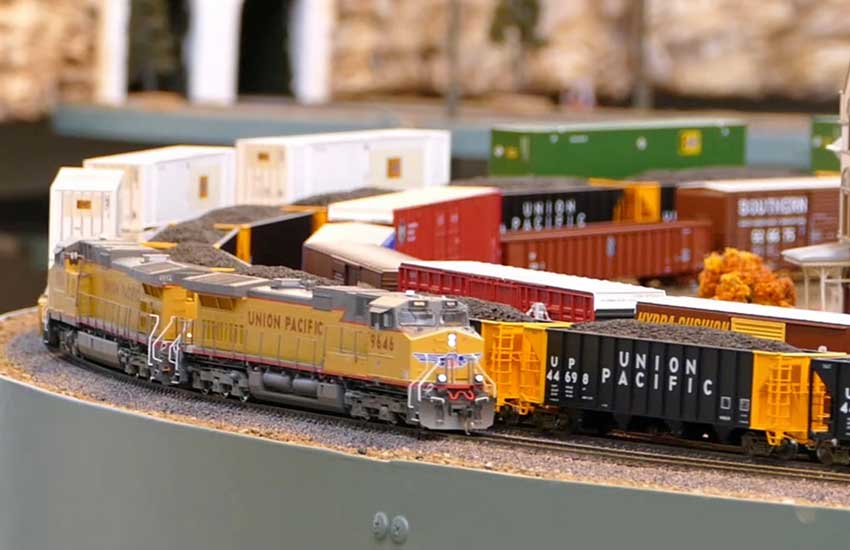 Enjoy this exciting tour of Richard's layout in a purpose-built 640-square foot hobbyist train building! Designed for private operating sessions with friends, this modern-day HO-scale model railroad features 30 scale miles of track ascending a 3-level layout with a double-track mainline, 2 helixes, intricately detailed buildings and miniatures, plus gorgeous painted scenery throughout richly-imagined locales.
Enjoy this exciting tour of Richard's layout in a purpose-built 640-square foot hobbyist train building! Designed for private operating sessions with friends, this modern-day HO-scale model railroad features 30 scale miles of track ascending a 3-level layout with a double-track mainline, 2 helixes, intricately detailed buildings and miniatures, plus gorgeous painted scenery throughout richly-imagined locales.
Take a walkthrough tour of the layout as Richard provides stirring commentary, followed by a compelling music montage of the trains in operation! While still a work-in-progress, this layout is already packed with thrilling sights to be seen and a few fun surprises for fans of model trains!
† Video by Richard & John Eberli.
Back to QwikLinks| Rick Fortin | HO |
| Valley Division, Fourth District (ATSF) Valley to Mountains Ride • Mountains to Valley Ride |
|
| LDSIG Recommended Layout | |
Layout Owner Panel • Thursday, 7:00 – 8:00 PM • Zephyr Track
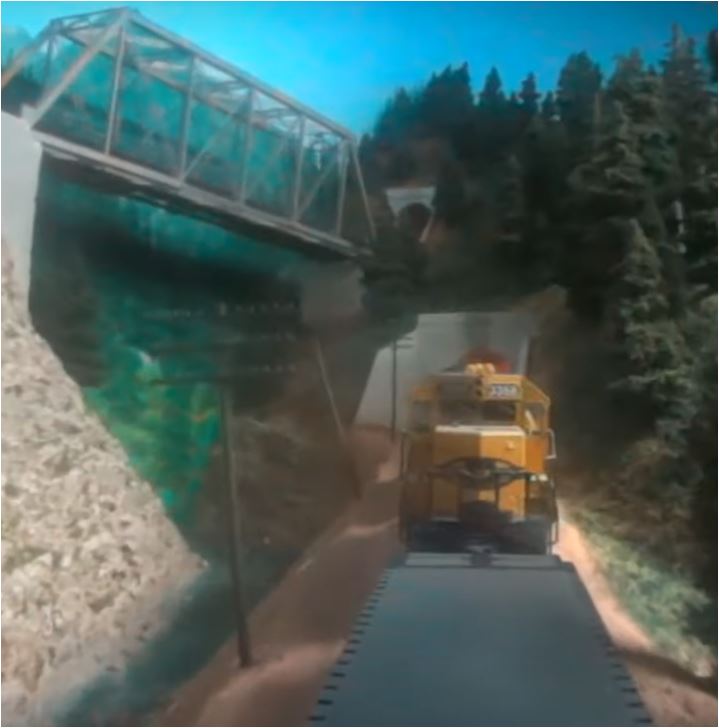 Proto-freelanced extension of the Santa Fe in the early 1970s north from the San Francisco Bay Area to Portland, OR. The modeled portion runs from the Central Valley town of Chico to McCloud, just south of Mount. Shasta in a purpose-built 25' x 47' room. The layout is a double-deck point-to-point, with 410 feet of mainline trackage, 50% scenicked, and the mainline 90% complete. Operations include a dispatcher, an interlocking tower, a large yard with two switch crews and a hostler, a small yard with a full-time switcher, heavy-duty mainline freight action with some passenger, local switching, and a branchline. All permanent track is all hand-laid. Operations are purposeful, in a relatively disciplined but casual atmosphere.
Proto-freelanced extension of the Santa Fe in the early 1970s north from the San Francisco Bay Area to Portland, OR. The modeled portion runs from the Central Valley town of Chico to McCloud, just south of Mount. Shasta in a purpose-built 25' x 47' room. The layout is a double-deck point-to-point, with 410 feet of mainline trackage, 50% scenicked, and the mainline 90% complete. Operations include a dispatcher, an interlocking tower, a large yard with two switch crews and a hostler, a small yard with a full-time switcher, heavy-duty mainline freight action with some passenger, local switching, and a branchline. All permanent track is all hand-laid. Operations are purposeful, in a relatively disciplined but casual atmosphere.
Train control is by NCE DCC with wireless throttles, FRS radios, and intercom, Track Warrants, real-time, sequence operations, car cards and waybills. Operators will appreciate fascia-mounted track diagrams, station names, mileposts, clipboards with train instructions, and track diagrams.
Signals are currently being installed for future CTC dispatching. Several of the sidings and junctions now have operational US&S R2 signals that are temporarily providing turnout position indication until Rick's ex-Santa Fe CTC machine is put into service. A dispatcher's office has been constructed adjacent to, but completely isolated from the layout room.
Website: www.lwmweb.com/sw&sf/
More photos and information on the BayRails website.
Back to QwikLinks| Free-mo | HO |
| Free Form Modular Layout | |
 This iteration of the Free-mo HO Scale layout was assembled for the 2019 NMRA National Train Show that took place in Salt Lake City, Utah in July of 2019. TSG was invited by Chris Palomarez to see the Free-mo layout and while we were at it, we decided to do a layout tour as well!
This iteration of the Free-mo HO Scale layout was assembled for the 2019 NMRA National Train Show that took place in Salt Lake City, Utah in July of 2019. TSG was invited by Chris Palomarez to see the Free-mo layout and while we were at it, we decided to do a layout tour as well!
Join us for a look at how the Free-mo folks handle the challenge of setting up at train shows with different modules in different spaces every time.
Free-mo was envisioned and started by Chris Palomarez at the San Luis Obispo Model Railroad Club (now SLOMRA). In about 1994 Chris looked at the club NMRA modules and said, "Why are we running in a circle? The prototype does not go in a circle, it goes point-to-point." Based off the FREMO concept that was being used in Europe, he and Art Armstrong sat down and wrote out the first standards for Free-mo.
In October of 1995 SLOMRC had a setup in Paso Robles that used a point-to-loop setup combining the new Free-mo Modules with old NMRA modules. This was the first public Free-mo setup.
For more information on Free-mo, see their website: www.free-mo.org
Back to QwikLinks| Ed Gregory | N |
| Bull Horn Flats |
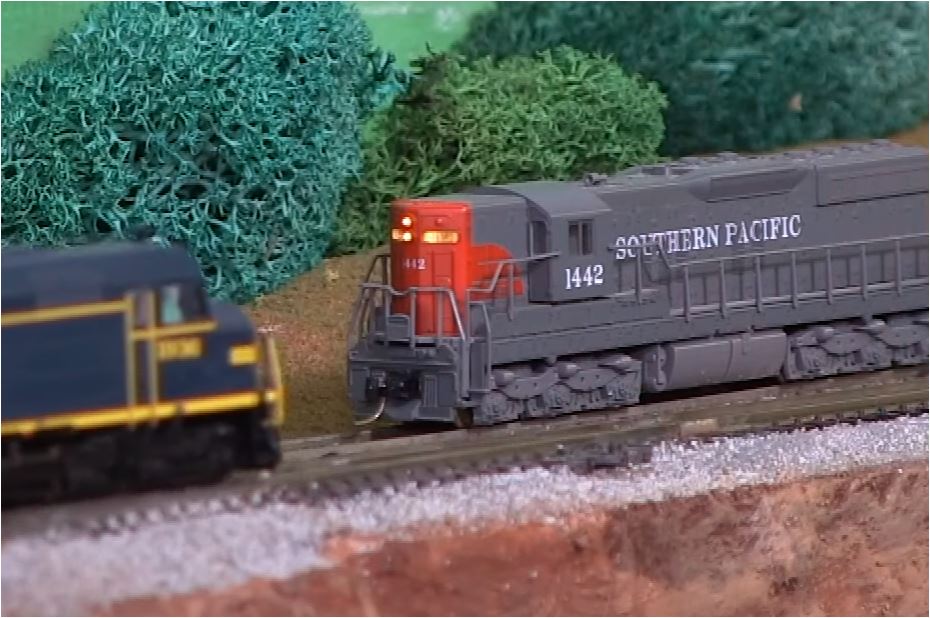 The Bull Horn Flats is a fictitious caboose-era proto-freelance layout with 8 switching areas, all with run-around tracks, as well as 14 passing sidings, 2 yards, 2 reversing loops, and 2 interchange tracks, with mostly freight and a passenger local. Turnouts are all hand thrown, simulating brakemen getting off and on locomotives to do work. Operations uses car cards and switch lists. The layout shows what could have been if the Santa Fe had gone south from Richmond to Fremont, California, and then east to nearby Altamont Pass. Control is by Digitrax DCC.
The Bull Horn Flats is a fictitious caboose-era proto-freelance layout with 8 switching areas, all with run-around tracks, as well as 14 passing sidings, 2 yards, 2 reversing loops, and 2 interchange tracks, with mostly freight and a passenger local. Turnouts are all hand thrown, simulating brakemen getting off and on locomotives to do work. Operations uses car cards and switch lists. The layout shows what could have been if the Santa Fe had gone south from Richmond to Fremont, California, and then east to nearby Altamont Pass. Control is by Digitrax DCC.
| Steve Hayes | HO |
| Western Pacific 1967 | |
| LDSIG Recommended Layout |
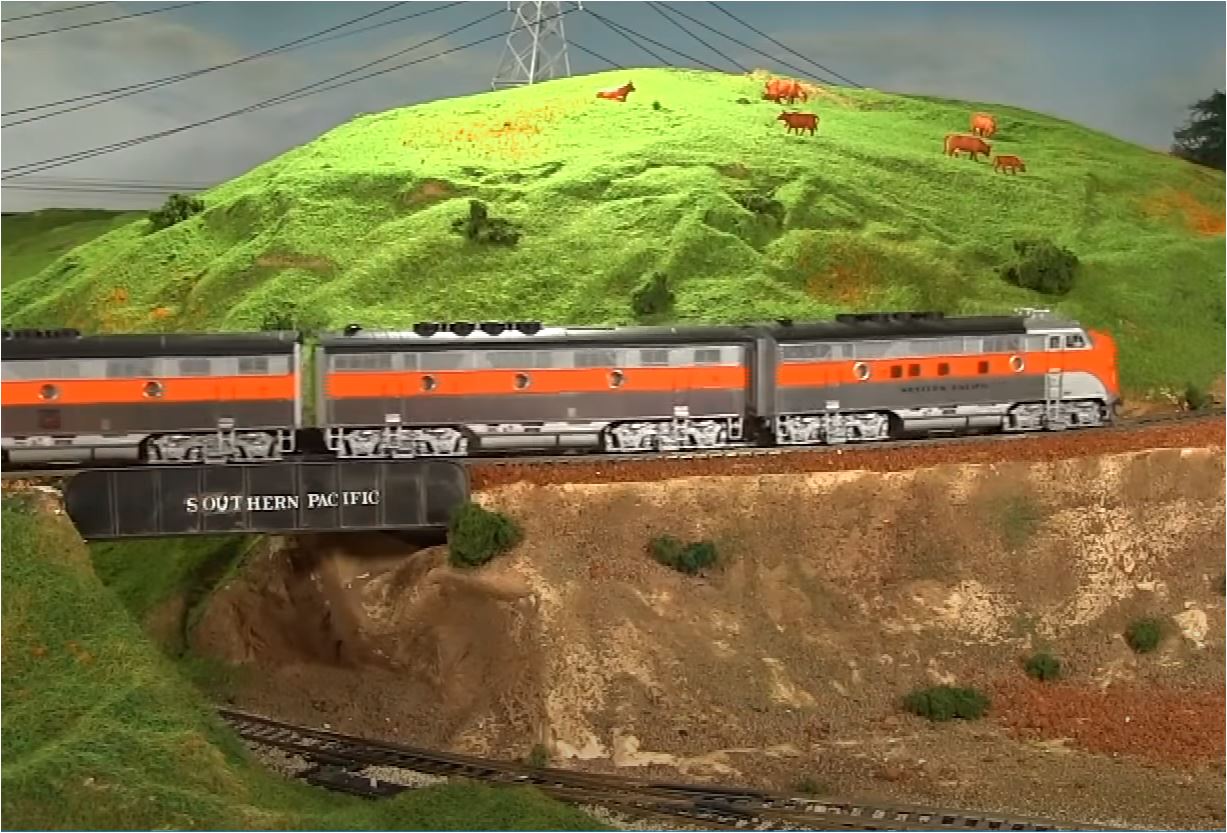 One of the larger private layouts we've toured, this massive HO Scale DCC-equipped model railroad layout is located in Twain Harte, CA. It's owned by Steve Hayes, who happens to also be the author of several books, including two about the Western Pacific.
One of the larger private layouts we've toured, this massive HO Scale DCC-equipped model railroad layout is located in Twain Harte, CA. It's owned by Steve Hayes, who happens to also be the author of several books, including two about the Western Pacific.
The layout depicts the WP in 1965-69 from Oakland to Salt Lake City in an 1800 sq feet basement with 700 feet of single track mainline and 9 passing sidings. The layout is 70% scenicked with several prototype structures. This layout attempts to evoke a specific era and locations with some compromises to improve modeled operations. Operations are purposeful and include the California Zephyr and 20+ freight trains during a 4-hours operating session over a fully signaled mainline.
More photos and information on the BayRails website.
Website: steveswplayout.hayeswp.com/
Back to QwikLinks| Kevin & Curtis Hill | G/Fn3 |
| San Benito Southern Railroad |
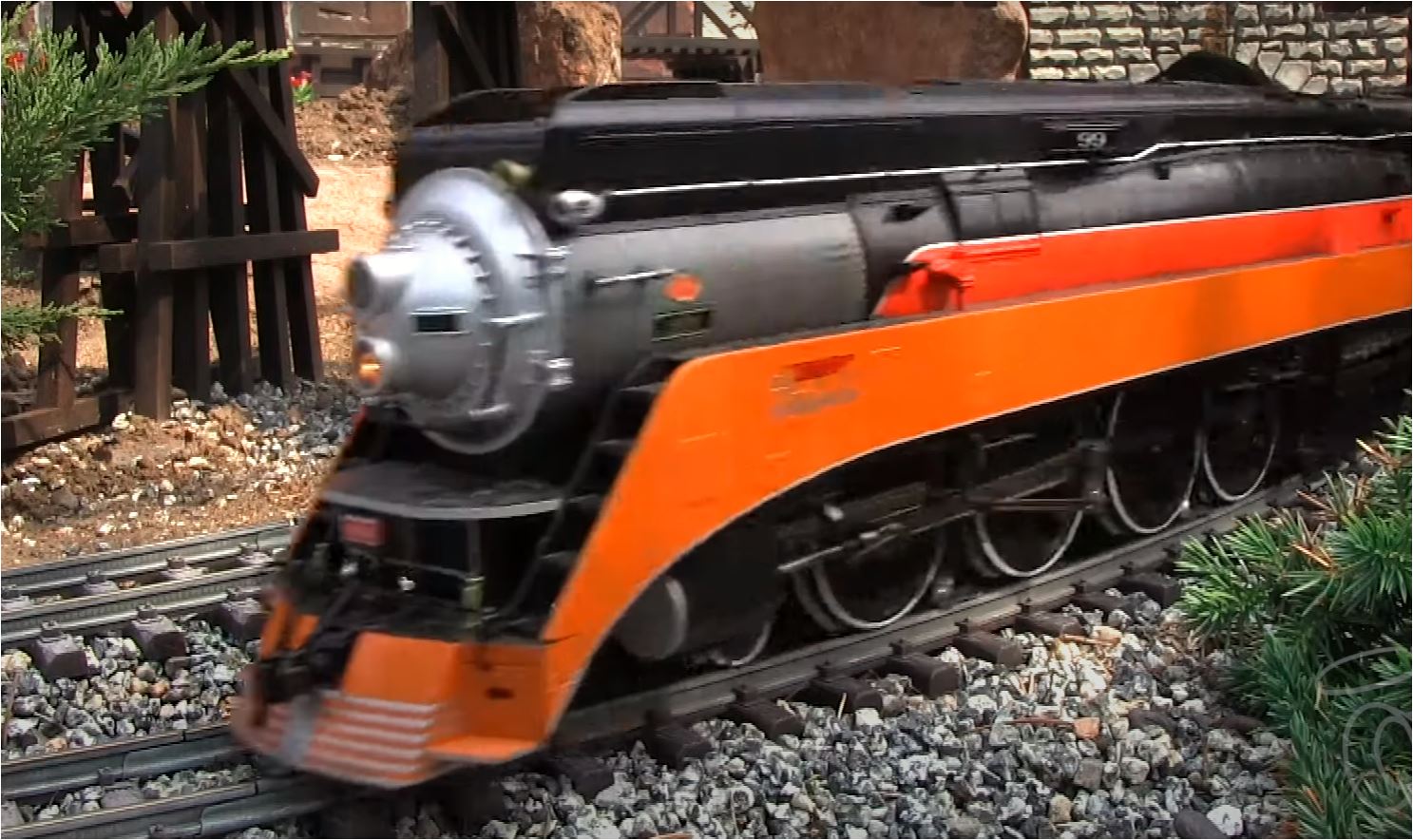 The San Benito Southern is located in Hollister and was built by Kevin and Curtis Hill. While the garden railroad is a centerpiece of the yard, so is some of the railroadiana in the yard. Not just historic relics, but in some cases, historic relics with very personal connections!
The San Benito Southern is located in Hollister and was built by Kevin and Curtis Hill. While the garden railroad is a centerpiece of the yard, so is some of the railroadiana in the yard. Not just historic relics, but in some cases, historic relics with very personal connections!
It's not just about locomotives and trains; combine a very nicely manicured garden layout with great equipment and lots of Disney historical elements and you get the San Benito Southern.
Back to QwikLinks| Dave Houston | HO |
| Southern Pacific Rocklin Sub | |
| LDSIG Recommended Layout |
Layout Owner Panel • Saturday, 7:00 – 8:00 PM • Zephyr Track
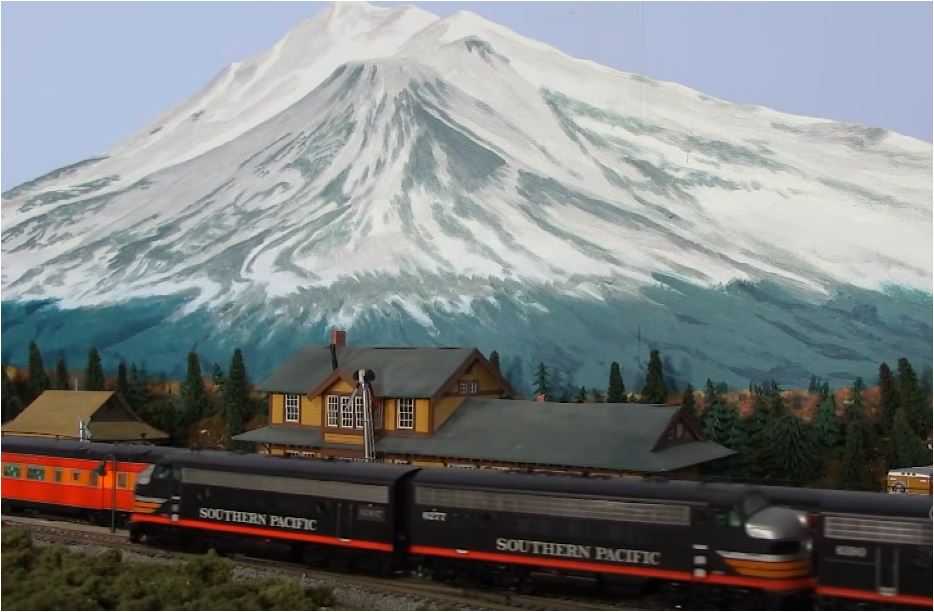 Most of us know Daylight Dave from the train shows. He had the booth with all the jackets, hats, shirts, and other railroad branded items. Did you know Dave is also a model railroader?
Most of us know Daylight Dave from the train shows. He had the booth with all the jackets, hats, shirts, and other railroad branded items. Did you know Dave is also a model railroader?
Join us for a look at Dave's Southern Pacific Rocklin Sub HO Scale layout, a freelanced version of the SP Donner and Shasta crossings, as well as the Coast Line and Burbank Branch in the 50s.
A walk-in basement in California is not very common, but this one was available (house included) and a dream has become a reality. At 11x55 feet in size, a completed (yes, you read that right!) double-deck freelance prototype layout. Emphasis is on operations with car cards, track warrants, long trains, and two-person crews. Digitrax DCC and sound in nearly every locomotive make the scene complete.
More photos and information on the BayRails website.
Back to QwikLinks| Bill Kaufman | HO |
| State Belt Railroad | |
| LDSIG Recommended Layout | |
Layout Owner Panel • Saturday, 7:00 – 8:00 PM • Zephyr Track
 The State Belt ran for a hundred years along the piers and into the warehouses of the San Francisco waterfront. Bill has taken important elements like the car float, the interchange at King St. (where the sometime World Champion San Francisco Giants play baseball today), the street running, and the switching areas under Telegraph Hill and built them into a 12' by 12' layout using some interesting modular techniques.
The State Belt ran for a hundred years along the piers and into the warehouses of the San Francisco waterfront. Bill has taken important elements like the car float, the interchange at King St. (where the sometime World Champion San Francisco Giants play baseball today), the street running, and the switching areas under Telegraph Hill and built them into a 12' by 12' layout using some interesting modular techniques.
The operations themselves follow the pattern of the actual State Belt, with two crews each working its own division. The railroad was and is controlled by switchlists. The prototype never handled waybills or any other official documents. Each of the connecting railroads sent a switchlist with its cars and the railroad charged them for each movement, irrespective of contents or distance. We use a "Chief Clerk" who, using a standard car card and waybill system, simulates the ATSF, SP, WP and Northwestern Pacific railroads car forwarding system and writes the switchlists. The "staging" on the layout consists of three carfloats and three cassettes that attach temporarily to the end of various streets.
The railroad itself is built and totally functional. Basic buildings and scenery are in place. About 125 cars are switched each session with a motive power department of two sound equipped 0-6-0s and four Alco S-2s with LokSound chips. The locomotive control system is Lenz with CVP wireless throttles. All switches are hand thrown because that was the way it was on the State Belt.
The April 2007 issue of Model Railroad Craftsman magazine had an article on the layout and Bill has written a book, The State Belt, published by Signature Press, now in its second printing.
More photos and information on the BayRails website.
Website: www.statebelt.org
Back to QwikLinks| Mike Laine | HO |
| Virginia & Truckee Railroad | |
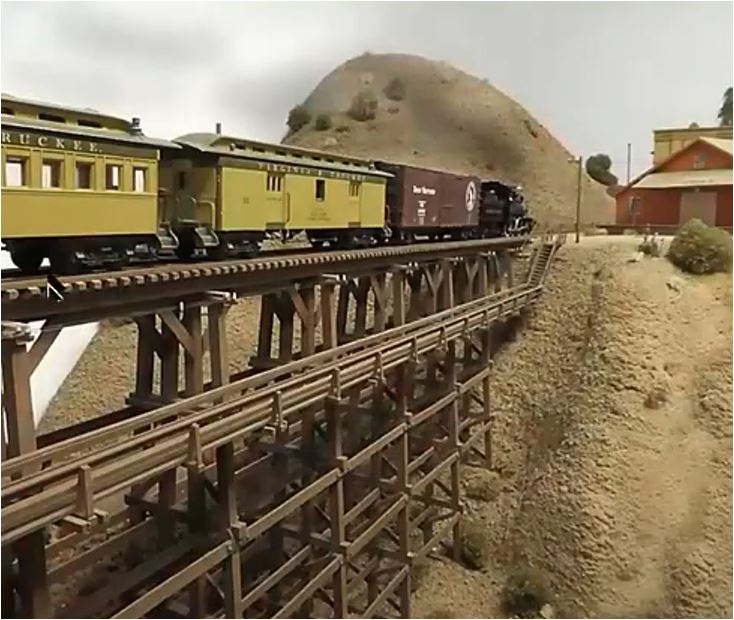 The 5' x 12' eye-level walk-in layout depicts the Virginia and Truckee Railroad's venerable line to the famous mining town of Virginia City, Nevada. Now reduced to a quiet western branch line, the layout depicts the declining mining district as it might have appeared in the mid-1930s. Virginia City, Gold Hill and the Crown Point trestle are featured highlights. The layout has many scratchbuilt and kitbashed historic structures and is finished with natural materials collected on-site in Nevada.
The 5' x 12' eye-level walk-in layout depicts the Virginia and Truckee Railroad's venerable line to the famous mining town of Virginia City, Nevada. Now reduced to a quiet western branch line, the layout depicts the declining mining district as it might have appeared in the mid-1930s. Virginia City, Gold Hill and the Crown Point trestle are featured highlights. The layout has many scratchbuilt and kitbashed historic structures and is finished with natural materials collected on-site in Nevada.
This layout is in an enclosed room constructed in a typical California garage. The layout was built as a demonstration project for the NMRA 2000 National Convention in San Jose. Control is DC with blocks.
Back to QwikLinks| Howard Lloyd | HO |
| Claremont Docks Railroad | |
| LDSIG Recommended Layout | |
Layout Owner Panel • Friday, 7:00 – 8:00 PM • Zephyr Track
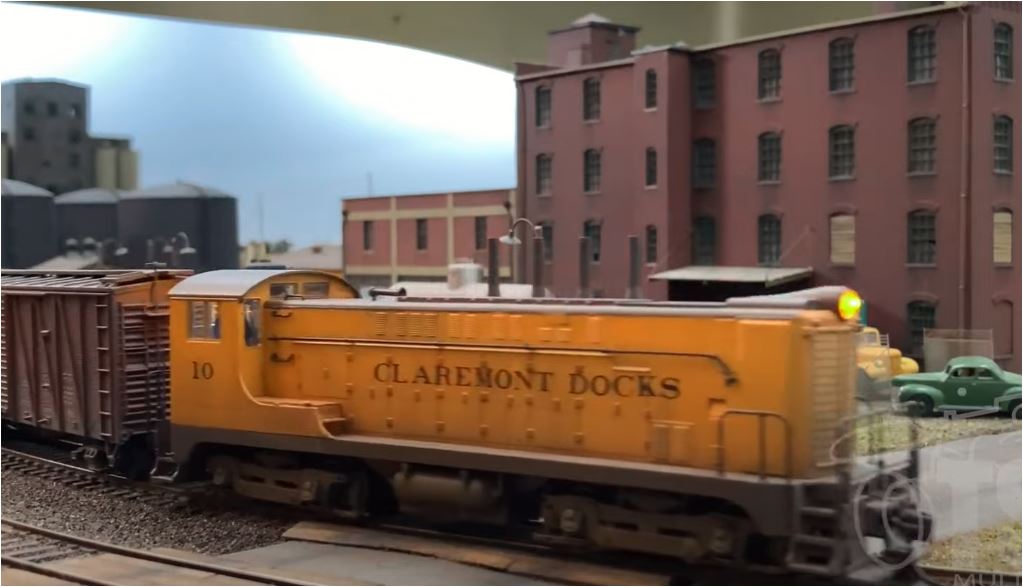 The Claremont Docks Railroad is Howard's rendition of a 1940s railroad terminal in the New York Harbor area. This is a stunning HO scale layout with a strong maritime element. The confluence of maritime and railroad modes of transportation are shown off in this one, and doing it in the broader context of the New York Harbor region in the 1940s really works.
The Claremont Docks Railroad is Howard's rendition of a 1940s railroad terminal in the New York Harbor area. This is a stunning HO scale layout with a strong maritime element. The confluence of maritime and railroad modes of transportation are shown off in this one, and doing it in the broader context of the New York Harbor region in the 1940s really works.
This 12' x 17' freelanced switching layout was inspired by the Lehigh Valley's small "Black Tom" terminal, which jutted into New York Harbor from Jersey City, New Jersey. It is September 1944, and the terminal is busy with war material bound for the European theater.
Most structures are scratch-built (ie: a large brick warehouse, a very long corrugated freight shed, a terminal grain elevator). Howard also likes to build boats, and so far there are 5 of them on the layout. The layout does operate, but he is more interested in building what he hopes is a realistic rail-marine diorama.
Benchwork is open grid and L-girder, at a height of 53"–56-¼". The mainline run is 39 feet, with a minimum radius of 18" and a maximum grade of 3%. Track is code 83 on Homasote roadbed. Scenery consists of "ground goop" and ground foam on plywood. The backdrop is painted tempered hardboard. Control is by wirelss NCE DCC.
The track plan originally appeared in the July 2017 issue of Model Railroader magazine. His previous layout, the Arvern Bay Terminal, was twice featured in photo spreads in Model Railroader magazine.
Back to QwikLinks| Ed Loizeaux | S |
| New York Central Valley Division | |
| LDSIG Recommended Layout | |
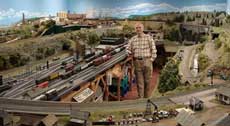 Over 300 feet of double-tracked mainline with working DTC/ABS signaling in both directions, working semaphores, wireless control panels for the main yard, working turntable, computerized remote dispatching, a working 1950s-era telephone system and about 90 SwitchMaster-powered turnouts. Primary scenic features of this 20' x 30' layout include a 6' tall waterfall, a cut stone viaduct over 10' long, rain storm with flashing lightning and loud thunder, a large deck truss bridge, Mike Kotowski's professionally-painted backdrop, dozens and dozens of beautiful pine trees and billions of grains of ballast.
Over 300 feet of double-tracked mainline with working DTC/ABS signaling in both directions, working semaphores, wireless control panels for the main yard, working turntable, computerized remote dispatching, a working 1950s-era telephone system and about 90 SwitchMaster-powered turnouts. Primary scenic features of this 20' x 30' layout include a 6' tall waterfall, a cut stone viaduct over 10' long, rain storm with flashing lightning and loud thunder, a large deck truss bridge, Mike Kotowski's professionally-painted backdrop, dozens and dozens of beautiful pine trees and billions of grains of ballast.
Control by wireless NCE DCC, CMR/I, JMRI, and DC.
This is NOT your father's American Flyer train set. It is genuine S scale model railroading. Visitors are encouraged to run a train while here. It's more fun per minute than watching TV! Caution: Crawlunder to enter layout room.
Website: sscale.org/best-of-s/ed-loizeaux/
Back to QwikLinks| Otis McGee | HO |
| Southern Pacific Shasta Route | |
| LDSIG Recommended Layout |
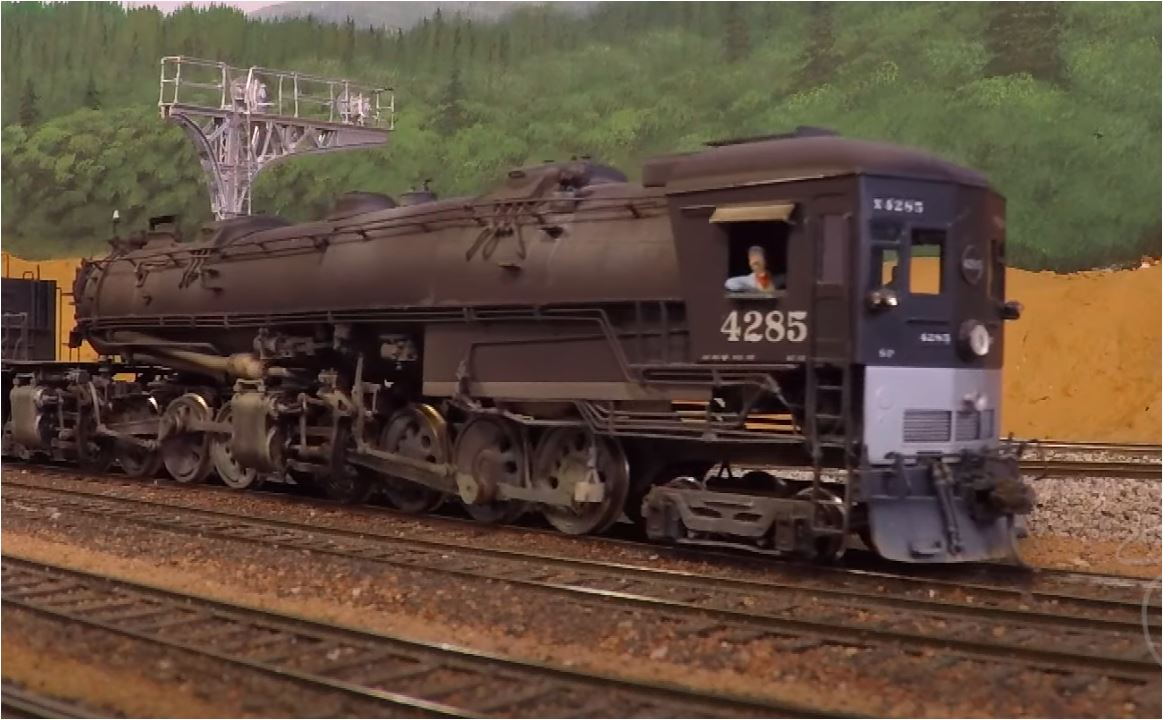 This double-decked, mushroom-style layout is a model of SP's storied Shasta Division from Redding, CA to Klamath Falls, OR, located in a purpose-built 1,200 sq ft loft in the Oakland Hills overlooking San Francisco Bay. The Shasta Division is the last large layout designed by the late and legendary John Armstrong. Operations follow the prototype using a modified 1952 prototype timetable & train orders and CTC. The layout is faithful to the prototype. Car forwarding is by "Thompson" waybills. Trackside maps document the switching areas, and train briefs are provided.
This double-decked, mushroom-style layout is a model of SP's storied Shasta Division from Redding, CA to Klamath Falls, OR, located in a purpose-built 1,200 sq ft loft in the Oakland Hills overlooking San Francisco Bay. The Shasta Division is the last large layout designed by the late and legendary John Armstrong. Operations follow the prototype using a modified 1952 prototype timetable & train orders and CTC. The layout is faithful to the prototype. Car forwarding is by "Thompson" waybills. Trackside maps document the switching areas, and train briefs are provided.
The original John Armstrong design was modified in significant respects, largely to achieve operational goals. For example, sidings and spurs were added or modified to add operational interest. Some trackage was eliminated to create more interesting, and lengthy runs between modeled towns. Most significantly, the capacity of the designed hidden staging yards at Redding and Klamath Falls was increased from 4 to 7 tracks. Additional staging tracks were added at Weed and lengthened from 8' to nearly 20'. And, additional tracks were installed at the visible lower Dunsmuir yard.
The track is ME rail on CVP tie strips with hand-laid turnouts, with nearly 400 feet of mainline trackage. Train control is via wireless NCE DCC. The layout is fully signaled from Redding to Black Butte (the CTC section) and ABS signaling is now being installed, per the prototype, from Black Butte to Klamath Falls. Computer interface is accomplished using C/MRI hardware and JMRI software. The tone of the layout is casual but purposeful.
The Shasta Division is 60% scenicked with painted backdrops from Redding to Dorris. Many key structures are in place or mocked up, giving the modeled scenes a sense of place For example, the Dunsmuir engine facility and city structures are complete and in place.
The layout accommodates 13 operators, including a yard crew of 3, two dispatchers (one CTC and one TT & TO), two TO operators, and road crews.
The SP Shasta Division is featured in Great Model Railroads 2011.
Website: www.spshastaroute.org/
More photos and information on the BayRails website.
Back to QwikLinks| Ed Merrin | HO |
| Northwestern Pacific ‡ | |
| LDSIG Recommended Layout |
Layout Owner Panel • Saturday, 7:00 – 8:00 PM • Zephyr Track
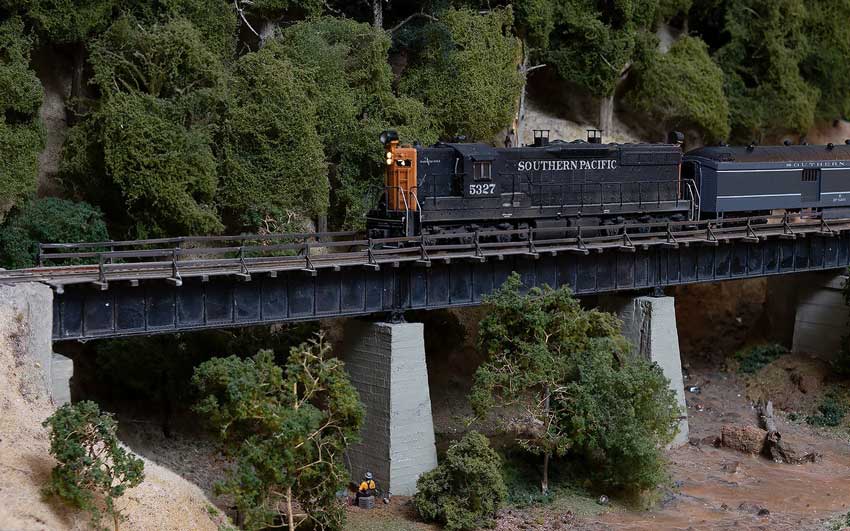 The goal of this layout is to capture the look and feel of the late 1950s Northwestern Pacific Railroad, a former subsidiary of the SP that ran north of San Francisco from Tiburon and Sausalito on the San Francisco Bay to the Humboldt Bay city of Eureka. The resulting 13x17 foot layout features two visible levels, with a third level below for staging. The levels are connected by two helixes. The lower level depicts scenes in Sonoma County, including the towns of Petaluma and Santa Rosa, and on the upper level are parts of Mendocino County, including the division point at Willits.
The goal of this layout is to capture the look and feel of the late 1950s Northwestern Pacific Railroad, a former subsidiary of the SP that ran north of San Francisco from Tiburon and Sausalito on the San Francisco Bay to the Humboldt Bay city of Eureka. The resulting 13x17 foot layout features two visible levels, with a third level below for staging. The levels are connected by two helixes. The lower level depicts scenes in Sonoma County, including the towns of Petaluma and Santa Rosa, and on the upper level are parts of Mendocino County, including the division point at Willits.
Like its 1958 prototype, motive power is dominated by EMD SD7s, with a few SD9s, mostly in the Black Widow paint scheme. Most engines have sound. Operationally, the most significant business of the railroad is bringing lumber down from the northern counties on second-class freights, (compass south but SP westward) with empties returning on eastward extras. There are also locals and passenger service. The Petaluma and Santa Rosa Railroad, once an independent electric line but now dieselized and an NWP-owned subsidiary, is also depicted, with separate trackage and live interchanges.
Faithful to the prototype, the railroad is dark and runs with timetable and train orders on a fast clock. A prototype 1958 NWP timetable was the model for the train movements. Train orders and clearance forms are pre-written for each session, although dispatchers have the option of writing their own orders for which blank forms and carbons are provided. Car routing uses the traditional car card/waybill system.
The railroad operates with Lenz DDC equipment supplemented by CVP radio throttles. A large hidden staging yard, fitted with stationary decoders, is controlled manually by operators or by the dispatcher using JMRI PanelPro with programmed routes.
Nearly the entire layout has at least basic scenery. There are both scratchbuilt and kitbashed trestles and bridges and a growing number of structures based on prototype facilities and scenes.
More photos and information on the BayRails website.
‡ Video used with permission of Model Railroad Operations.
Back to QwikLinks| Napa Valley Model Railroad Historical Society | HO |
| Napa Valley Northern | |
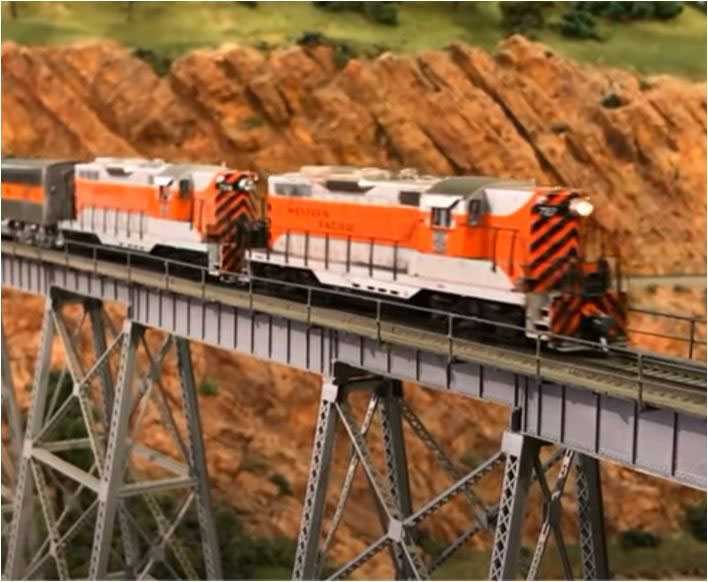 The Napa Valley Northern was a fictional line that ran from Stockton, CA to Portland, OR. The modeled portion of the line was based on a former Southern Pacific branchline from Napa, CA to Ukiah, CA. A hidden staging yard represented both Stockton and Portland.
The Napa Valley Northern was a fictional line that ran from Stockton, CA to Portland, OR. The modeled portion of the line was based on a former Southern Pacific branchline from Napa, CA to Ukiah, CA. A hidden staging yard represented both Stockton and Portland.
The theme was a double-track to single-track class I railroad, set in the 1940s to the present time. Except for themed operating sessions, members could run equipment from any era.
Unfortunately, as this is being typed (3/28/21), the layout is in the process of being dismantled after the Society lost its four-year legal battle with landlord Napa Valley Expo Board and has been evicted from their clubhouse. Another Fallen Flag!
Website: nvmrc.org
Back to QwikLinks| Seth Neumann | HO |
| Union Pacific Oakland Subdivision | |
| LDSIG Recommended Layout | |
Layout Owner Panel • Tuesday, 8:00 – 9:00 PM • Zephyr Track
 The layout is set in the San Francisco East Bay Area in 1999. The railroad represents the former Western Pacific 1st and San Jose Subdivisions, which had become the UP Niles, Oakland, and Milpitas Subdivisions in the era modeled. The railroad is a secondary main and a branchline that supports an Auto plant (NUMMI) and a number of smaller industries. The layout is about 95% scenicked.
The layout is set in the San Francisco East Bay Area in 1999. The railroad represents the former Western Pacific 1st and San Jose Subdivisions, which had become the UP Niles, Oakland, and Milpitas Subdivisions in the era modeled. The railroad is a secondary main and a branchline that supports an Auto plant (NUMMI) and a number of smaller industries. The layout is about 95% scenicked.
The single-level layout is built in a 450 sqft purpose-built room. Dispatching is by TCS (using CATS) which replicates a Digicon console. Signal control is by CMRInet, including cpNodes made by Seth's company, Model Railroad Control Systems. All signals are repeated as color lite signals on repeaters above the layout. There is a complete writeup of the layout in Volume 52 of the Layout Design Journal, the publication of the Layout Design Special Interest Group, and a cover story in Railroad Model Craftsman, January 2018.
A unique feature of the layout is that there is no yardmaster, only a Clerk. This is because the prototype Milpitas Yard had no permanent switcher. The Clerk is assisted by a working RFID reader which prints “tracklists” of cars in order as a switch job pulls cuts over the reader. The RFID system appeared in Modeler Railroader, December 2014, page 46. The clerk is responsible for managing the yard and the neighboring NUMMI complex by writing switchlists to instruct the crews where to place cars. All crews do their own work when passing through the yard.
A typical session runs about 5 hours and uses 8 operators. Jobs include Dispatcher, Clerk, NUMMI Job (2 crew, 2 shifts), UP LRV54 Local, BNSF trackage rights local, and the Mission Bay local which includes a utility job called “The Critter Wrangler”.
Contol is by NCE DCC with wireless throttles, FRS Radios, 2:1 fast clock, and switchlists. All mainline engines have sound decoders. Uncoupling is 100% manual using pics.
Featured in July 2021 issue of NMRA Magazine.
More photos and information on the BayRails website.
Back to QwikLinks| Chuck Oraftik | HO |
| New York Central Railroad: Boston & Albany Division | |
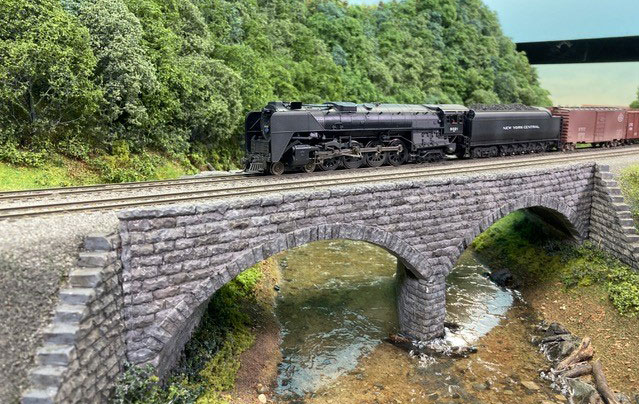 Welcome to Chuck Oraftik's basement. In this space, you can enjoy some great eastern United States transition-era model railroading. This layout has lush landscapes, pastoral countryside, amazing stone bridges, dense city scenes, and what's more, most of it is also lighted for night running!
Welcome to Chuck Oraftik's basement. In this space, you can enjoy some great eastern United States transition-era model railroading. This layout has lush landscapes, pastoral countryside, amazing stone bridges, dense city scenes, and what's more, most of it is also lighted for night running!
On Chuck's layout it's always early summer, mid-twentieth century America. Thousands of Supertrees blanket his rendition of the Berkshire Hills of western Massachusetts and eastern New York. This portion of the NYC's Boston & Albany division is a busy two-track mainline running through the Twin Ledges near Summit, along the Westfield River and through the Stateline Tunnels. Stops currently include Pittsfield, Richmond and Stateline, MA, as well as Canaan and Chatham, NY. Interchanges include the New Haven and Rutland.
Code 83 and 70 flex track is used with a 29 inch minimum radius. For possible relocation, the layout is built in seven, large transportable modules. Structures are kitbashed or scratch built to match or approximate the prototypes. All locomotives are sound equipped, while several are weathered and some have smoke units. Control is by NCE DCC.
Construction started about 20 years ago, but significant progress only began about 5 years ago. Recently, the Chair of the Board of Trustees has authorized a 370 square foot expansion going on to Albany and the Selkirk yard. This phase 2 right-of-way extension will transform the current 110 foot loop into a 200 foot loop-to-loop configuration.
This is Chuck's first "real" layout, but you probably wouldn't think so, considering how well done it is.
Featured in the May 2021 issue of Railroad Model Craftsman. (Click to read article)
Back to QwikLinks| Trevor Park | F |
| Fern Creek & Western Railroad | |
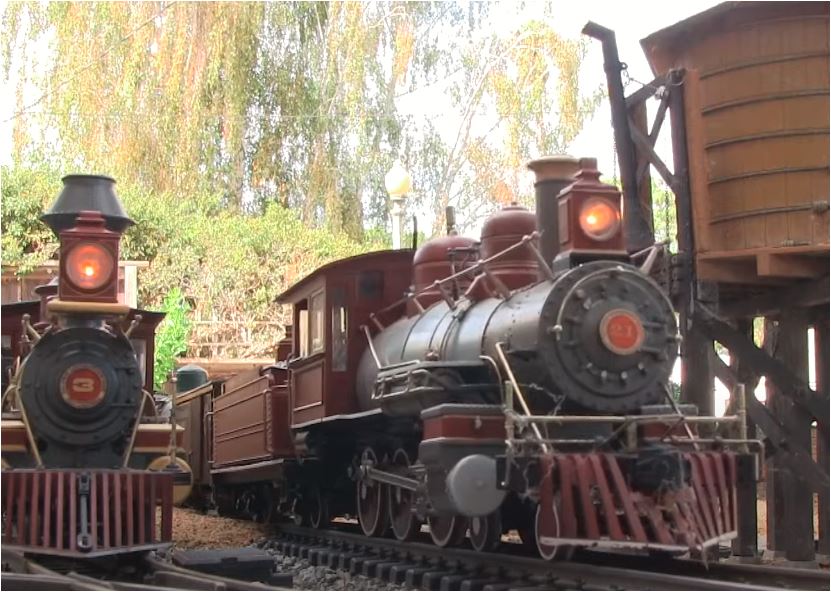 Trevor Park co-founded this DCC-equipped F Scale Narrow Gauge (Fn3) railroad in 2013 with Eric Child, and gives us a guided tour of the entire railroad. All video in this program was recorded in the Fall of 2015. If this doesn't inspire you to start your own garden railway or start your own modeling hobby, it's possible that nothing will!
Trevor Park co-founded this DCC-equipped F Scale Narrow Gauge (Fn3) railroad in 2013 with Eric Child, and gives us a guided tour of the entire railroad. All video in this program was recorded in the Fall of 2015. If this doesn't inspire you to start your own garden railway or start your own modeling hobby, it's possible that nothing will!
The Fern Creek and Western Railroad (FC&W) is a freelance garden layout based on the narrow gauge railroads of Coastal California. The railroad is set just before the 1920s when railroads and logging were still in their heyday. The railroad rises about two feet in its progression from the lowest point on the line to the summit, crossing many bridges, passing through two tunnels and climbing steep grades.
Website: fcwgrr.com
Back to QwikLinks| David Parks | HO |
| Cumberland West | |
| LDSIG Recommended Layout | |
Layout Owner Panel • Thursday, 7:00 – 8:00 PM • Zephyr Track
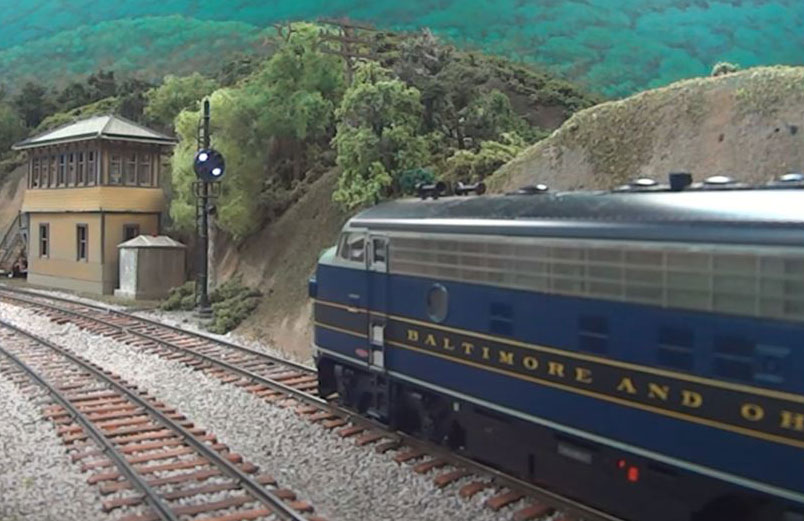 David's Cumberland West models the Western Maryland and Baltimore &Ohio railroads in the vicinity of Cumberland, Maryland in 1953. The layout is a single layer in a 1200 sq. ft. room with Mole staging. The backdrop, scenery, and bridges are mostly complete. Coal is the local focus. Both railroads have a Dispatcher, Stage Manager, and Coal Manager. The Coal Manager works with the Dispatcher to regulate coal loads and empty hopper traffic. An operating session focuses on one railroad with the other sometimes offering moving scenery.
David's Cumberland West models the Western Maryland and Baltimore &Ohio railroads in the vicinity of Cumberland, Maryland in 1953. The layout is a single layer in a 1200 sq. ft. room with Mole staging. The backdrop, scenery, and bridges are mostly complete. Coal is the local focus. Both railroads have a Dispatcher, Stage Manager, and Coal Manager. The Coal Manager works with the Dispatcher to regulate coal loads and empty hopper traffic. An operating session focuses on one railroad with the other sometimes offering moving scenery.
The B&O includes the junction of the Pittsburgh and Cumberland Divisions and part of the West End Sub. The B&O is double-track main with “Current of Traffic” rules using B&O 9-aspect Color Position Lights (CPL) signals. Five Tower Operators control interlocking sections. They use computer touch-screens to manipulate switches and signals with pseudo-Standard Signal graphics. The B&O has many named passenger trains and some passenger switching in Cumberland. B&O coal mines are off-line. Operations center on the Keyser coal switching yard and a small manifest yard.
The Western Maryland includes the junction in Cumberland, along with parts of the Thomas and Connellsville Subs. The WM is a single track with many on-line mines and uses timetable and train orders. Only a single passenger train is scheduled. Most station operator positions are unmanned and the train crews communicate with the dispatcher. WM local activity is dominated by local coal mines.
Both railroads are bridge lines with an abundance of through manifest traffic. Each railroad is operated independently of the other, except for interchanges and minor trackage rights.
NCE-DCC is used for train control while a separate Loconet controls signals and accessories. Stage routing is controlled via computer screens. Car forwarding uses car cards and waybills for manifest freights. Coal and empty hoppers use multi-car coal orders. Communications is via a 1950s era 14-station multi-line phone system. Variable speed fast clock.
Website: borail.net/DPCW/
More photos and information on the BayRails website.
Back to QwikLinks| Paul Patterson | HO |
| The Californian † | |
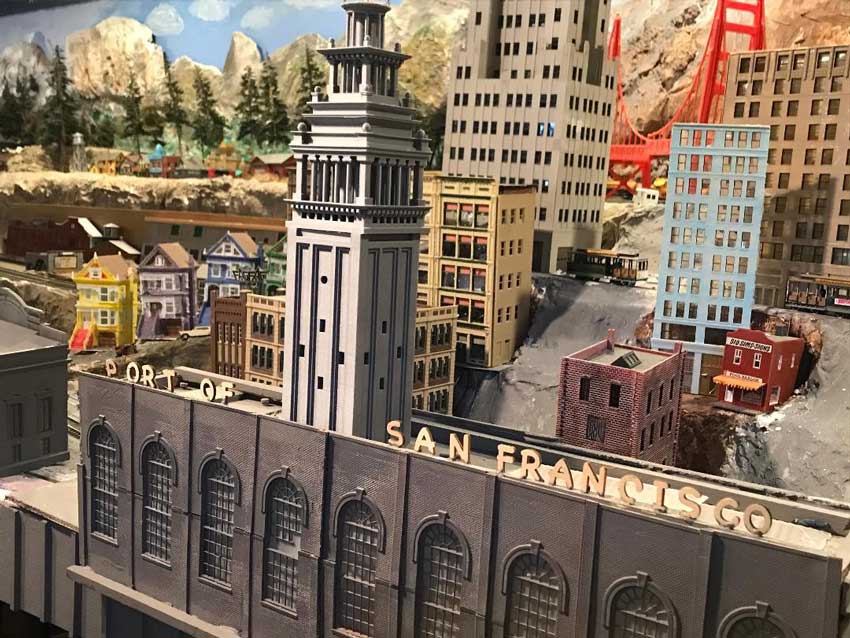 The Californian was inspired by Paul living in the state of California for several decades. The layout covers over 400 sq feet, has over 60 switches, 1500 feet of track, and was built over a span of 70 combined years. Two layouts were integrated into one. The older layout has handlaid track and Tru-Scale switches.
The Californian was inspired by Paul living in the state of California for several decades. The layout covers over 400 sq feet, has over 60 switches, 1500 feet of track, and was built over a span of 70 combined years. Two layouts were integrated into one. The older layout has handlaid track and Tru-Scale switches.
Featured are scenes from San Francisco, Los Gatos, Campbell, Yosemite, Disneyland, and the Sierra Nevada. There are over 50 structures, some made by 3D printing, but most of the structures are made of balsawood. The motive power roster includes over 50 steam and diesel locomotives, plus more than 400 pieces of rolling stock. This vintage layout still runs on DC and block control.
† Video courtesy of Paul Patterson.
Back to QwikLinks| Peninsula N-Trak | N |
| Modular Layout Tour | |
 Modular clubs like this commonly have exhibits at train shows because many of them do not have permanent places to setup and run on their layouts. As such, not all members are always available to display their modules at every show, so the exhibit varies from show to show. Join us as we take a look at Peninsula N-Trak's modular layout!
Modular clubs like this commonly have exhibits at train shows because many of them do not have permanent places to setup and run on their layouts. As such, not all members are always available to display their modules at every show, so the exhibit varies from show to show. Join us as we take a look at Peninsula N-Trak's modular layout!
Website: peninsulantrak.blogspot.com
Back to QwikLinks| Jim Providenza | HO |
| Santa Cruz Northern ‡ | |
| LDSIG Recommended Layout | |
Layout Owner Panel • Tuesday, 8:00 – 9:00 PM • Zephyr Track
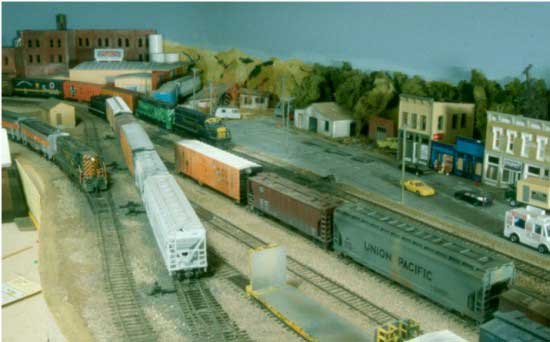 The Santa Cruz Northern is a proto-freelance WP/ATSF subsidiary over the California Coast Range in ’70-71. It is double-deck, walkaround, point-to-point 270’ long single track mainline, 90% scenicked, in a two-car garage. Operations closely adhere to prototype practices with through and local freights, a unit train, passenger operations, yard, and interchange. The Dispatcher works with two Agent/Operators, a Yardmaster, a Trainmaster, and train crews in a fairly disciplined but enjoyable atmosphere, replicating the teamwork inherent in railroading.
The Santa Cruz Northern is a proto-freelance WP/ATSF subsidiary over the California Coast Range in ’70-71. It is double-deck, walkaround, point-to-point 270’ long single track mainline, 90% scenicked, in a two-car garage. Operations closely adhere to prototype practices with through and local freights, a unit train, passenger operations, yard, and interchange. The Dispatcher works with two Agent/Operators, a Yardmaster, a Trainmaster, and train crews in a fairly disciplined but enjoyable atmosphere, replicating the teamwork inherent in railroading.
Control is by NCE DCC with wireless throttles, SoundTraxx decoders, telephone, TT&TO, 4:1 fast clock, car card and waybill / switchlist. Fascia mounted track diagrams, station names and mileposts, handouts describing layout and operating positions, and employee timetable.
The SCN has appeared as the subject of articles in Model Railroader, May 1996, Railroad Model Craftsman, November, December 2002, May 2010, and November 2011, Railmodel Journal, December 1999, Allen Keller Great Model Railroads Volume #35, and NMRA Magazine March 2021.
‡ Video used with permission of Model Railroad Operations.
More photos and information on the BayRails website.
Back to QwikLinks| San Leandro Historical RR Society | HO |
| Southern Pacific Overland Route |
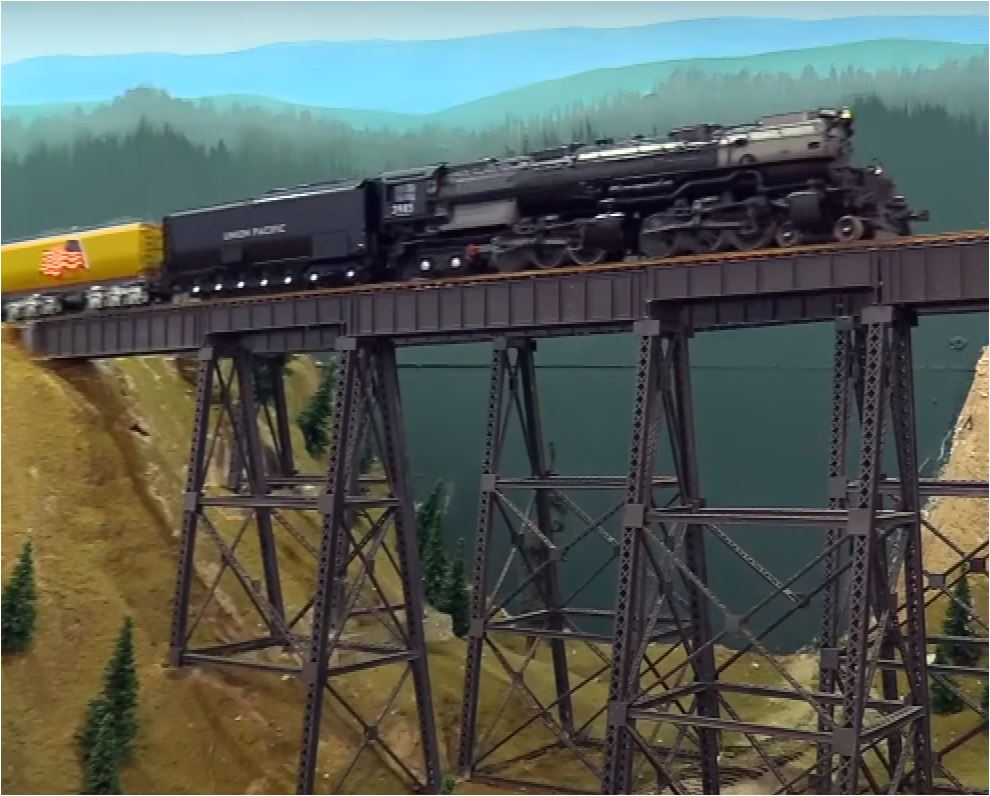 The San Leandro Historical Railway Society operates the historic 1898 Southern Pacific San Leandro Depot at Thrasher Park. Located in one room of the Depot is a railway museum and in the other room is the large HO scale display layout. This layout was designed by the legendary layout designer John Armstrong and was featured in the March 1998 Model Railroader magazine and depicts the Southern Pacific Railroad during the late steam to diesel transition era.
The San Leandro Historical Railway Society operates the historic 1898 Southern Pacific San Leandro Depot at Thrasher Park. Located in one room of the Depot is a railway museum and in the other room is the large HO scale display layout. This layout was designed by the legendary layout designer John Armstrong and was featured in the March 1998 Model Railroader magazine and depicts the Southern Pacific Railroad during the late steam to diesel transition era.
There are over 4,000 feet of track on 3 levels, dozens of switches, and miles of wiring that have been installed by SLHRS members. It takes about 45 minutes for a train to travel the entire length of the display at scale speed.
The HO scale display represents the Southern Pacific Overland Route from San Leandro, CA through a variety of cities along the way to Reno/Sparks, Nevada. This route can be followed today by taking Amtrak from Oakland to the station in Reno. Of special note, represented centrally in the display, is the icing platform in Roseville, CA that was used to supply the cars for the Pacific Fruit Express trains, the Alameda Mole, and the snowsheds of Donner Pass and Emigrant Gap.
Website: slhrs.org
Back to QwikLinks| Jon Schmidt | HO |
| Nicasio Northern Railroad ‡ | |
| LDSIG Recommended Layout | |
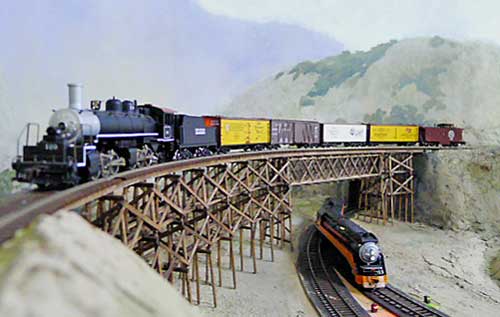 In the early 20th century, the farmers and ranchers of the North San Francisco Bay decided that they needed a way to get their product to market. They pooled their resources and built the Nicasio Southern Railroad from Nicasio, Marin County, to the port of Bayside on San Francisco Bay. Between underestimating the cost of construction and overestimating the traffic, the railroad failed. San Francisco financiers saw an opportunity, took over the railroad as the Nicasio Northern Railway, and extended it to Highland.
In the early 20th century, the farmers and ranchers of the North San Francisco Bay decided that they needed a way to get their product to market. They pooled their resources and built the Nicasio Southern Railroad from Nicasio, Marin County, to the port of Bayside on San Francisco Bay. Between underestimating the cost of construction and overestimating the traffic, the railroad failed. San Francisco financiers saw an opportunity, took over the railroad as the Nicasio Northern Railway, and extended it to Highland.
At this time (1924, approximately) the road is barely surviving. The Nicasio Northern is a short line, best characterized as a freelanced “rails-in-the-mud” San Francisco North Bay railroad. It operates both freight and passenger trains, including a ferry schedule to San Francisco. Its route goes from Bayside to Highland in the north (railroad east). There is a branch from Skalville to Yawn which is the connection to the national rail network. Lots of switching activity in Bayside with the wharf, local industries, and the passenger yard. The railroad operates several freight and passenger trains each day.
The Nicasio Northern Railway weaves through the hills on muddy and slippery roadbed. Need I mention that this is earthquake country? Even if the right of way was once perfectly laid out with straight tangents and smooth grades and curves, it didn’t stay that way. The little steam engines rock and roll as they lead their trains across the pike.
The Nicasio Northern is an HO-scale model railroad designed for TT&TO operation with switchlists. It runs only steam, with Soundtraxx sound in the locomotives and Digitrax DCC for control. We run a 4:1 fast clock. Trackwork is complete and operational. The scenery is about 30% complete. The layout has a peninsula in the center of the 12' x 21' space, while the rest of the track runs around the perimeter of the room. Bayside yards and the engine terminal are on the peninsula. It has 28” aisles. It is NOT handicapped accessible (stairs).
‡ Video used with permission of Model Railroad Operations.
More photos and information on the: BayRails website.
Website: nnrwy.trxndesign.com
Back to QwikLinks| Silicon Valley Lines Club | HO |
| Silicon Valley Lines | |
Layout Owner Panel • Tuesday, 7:00 – 8:00 PM • Zephyr Track
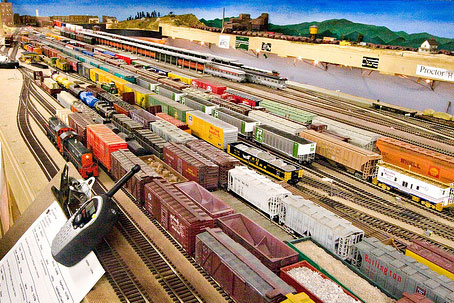 Founded in 1979, Silicon Valley Lines (SVL) is a freelance HO scale model railroad club located in San Jose, California. Construction of the current layout began in late 2000 and is located in the basement of an industrial building near downtown San Jose. The railroad occupies a 23’ x 72’ space and is a multi-level design built using commercial steel C-channel as a benchwork system with over 600 feet of mainline. The upper level is a single-track division, while much of the lower level is double-tracked. The layout features two large operating yards, as well as ample hidden, yet accessible staging.
Founded in 1979, Silicon Valley Lines (SVL) is a freelance HO scale model railroad club located in San Jose, California. Construction of the current layout began in late 2000 and is located in the basement of an industrial building near downtown San Jose. The railroad occupies a 23’ x 72’ space and is a multi-level design built using commercial steel C-channel as a benchwork system with over 600 feet of mainline. The upper level is a single-track division, while much of the lower level is double-tracked. The layout features two large operating yards, as well as ample hidden, yet accessible staging.
Basic scenery is about 50% completed with painted backdrops and some key structures in place. Scenery construction, tuning operations, and refining the electrical control systems of the layout are now the top priorities for the club.
Realistic operation has always been a key focus in the SVL club. Throughout construction, members have been operating monthly on the layout to ensure that the railroad is built to create an enjoyable experience for our members and guests. Generous aisles provide ample space to support up to 8 simultaneous train crews and we are capable of running more than 25 trains on a good night.
Just like the former Southern Pacific, SVL utilizes Direct Traffic Control (DTC) to keep trains moving on the railroad. Crews use radios to obtain authority from a dispatcher, and engineers are given switch-lists that describe the work. Switch-lists for each session are generated using a new software system (Spar) developed by one of our members.
The club was an early adopter of command control, starting with the Keller Onboard system in the 1980s, and quickly transitioning to Digital Command Control in 1995. Layout control uses NCE DCC with support for both plug-in and wireless throttles, as well as WiFi-throttles using JMRI WiThrottle. Turnout control around the layout is done using touch screens. The dispatcher desk is integrated with that system as well and controls signals and turnouts remotely.
Featured in the December 2020 issue of: NMRA Magazine.
Website: siliconvalleylines.com
More photos and information on the BayRails website.
Back to QwikLinks| Ernie Simard | HO |
| Western Pacific ‡ | |
| LDSIG Recommended Layout | |
 Operations on the Western Pacific in the desert and the mountains in the early 1950s are the focus of Ernie Simard's layout. Railroad operations center on the division point yard at Portola, with trains running west and then north on the WP's High Line, and east on the mainline across Nevada and Utah to the Rio Grande's Roper Yard in Salt Lake City.
Operations on the Western Pacific in the desert and the mountains in the early 1950s are the focus of Ernie Simard's layout. Railroad operations center on the division point yard at Portola, with trains running west and then north on the WP's High Line, and east on the mainline across Nevada and Utah to the Rio Grande's Roper Yard in Salt Lake City.
Ernie built a CTC machine to replicate the WP style of train control; authority is conveyed to train crews by signal indication. Operations are purposeful; as with almost any model railroad, Ernie has made some compromises with the prototype to make it all fit. Fascia-mounted track diagrams, station names and a timetable (for the passenger trains) create a solid information base for boomer train crews to facilitate their work.
The layout combines single and double deck construction in a three-car garage. The control system is Digitrax DCC. Ernie uses a fast clock; car forwarding is handled by switchlists. The layout is about 95% scenicked, with painted backdrop, rock and tree-covered mountains, towns and industries, etc.
‡ Video used with permission of Model Railroad Operations.
Back to QwikLinks| South Bay Historical Railroad Society | HO/N |
| HO Scale Layout • N Scale Layout | |
The SBHRS operates extensive HO and N-scale model displays, also known as "layouts," in the historic Santa Clara Depot (opened in 1863), across the street from Santa Clara University. Both layouts include extensive signaling. Like many model railroads, they are works in progress and are undergoing constant change.
Both layouts have many handcrafted scenes, such as a winery, dam, two helixes, row homes and a yacht harbor (N-scale) and meat packing, lumber mill, oil storage tanks, plus a replica of the San Jose Southern Pacific Depot, ca 1950 (HO-scale). Scenery is about 90% complete on both layouts. Handicapped access ramp on track side of depot. Control on both layouts is by Digitrax DCC.
Website: sbhrs.org
Back to QwikLinks| Dave Stanley | HO |
| Morada Belt Railway | |
| LDSIG Recommended Layout | |
Layout Owner Panel • Tuesday, 7:00 – 8:00 PM • Zephyr Track
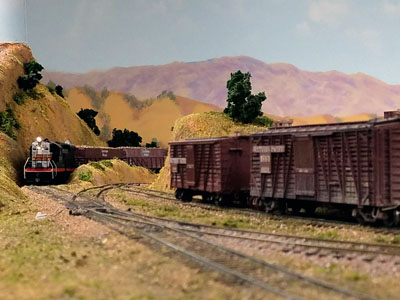 Featured in the January 2014 and November 2019 issues of Railroad Model Craftsman, the Morada Belt Railway is a freelanced HO railroad based in the West during the 1950s. Used by the four major carriers of the day (SP-WP-ATSF-UP) to reroute traffic when their lines are congested, the MB Ry also hosts a variety of trackage right carriers (usually two per session) so an occasional local freight from the Central California Traction Co. or, perhaps, the Milwaukee Road may make an appearance during an operating day.
Featured in the January 2014 and November 2019 issues of Railroad Model Craftsman, the Morada Belt Railway is a freelanced HO railroad based in the West during the 1950s. Used by the four major carriers of the day (SP-WP-ATSF-UP) to reroute traffic when their lines are congested, the MB Ry also hosts a variety of trackage right carriers (usually two per session) so an occasional local freight from the Central California Traction Co. or, perhaps, the Milwaukee Road may make an appearance during an operating day.
Housed in a separate 20' x 28' building, the layout is constructed on both two and three levels, connected by three single-loop helixes (blended into the scenery) providing a grade not exceeding 2.5% with a minimum mainline radius of 30 inches. The railroad was designed as a point-to-loop railroad due to space limitations but is run as a point-to-point operation (Palisade/Stockton staging yard to Morada classification yard). A separate yard (Junction City) is used by trackage right carriers to interchange with the “big four”. A branch line, plus a quarry, cement plant, produce district, and lumber mill, all located on the mainline, provide ample industry work for local freights dispatched from Morada Yard. The railroad is virtually completed with just a few structures to add.
Operating sessions require a train dispatcher (TWC-type train orders, transmitted by FRS radios), two yard engines at Morada Yard, one operator/switch engine at Junction City, and up to four mainline crews. Easy DCC is the control system and sessions normally last all day. All mainline and yard turnouts are Tortoise-powered, while branch line switches are push-pull using Blue Point machines.
More photos and information on the BayRails website.
Back to QwikLinks| Ted Stephens, MMR® | HO |
| Ohio & Little Kanawha Railroad | |
| LDSIG Recommended Layout | |
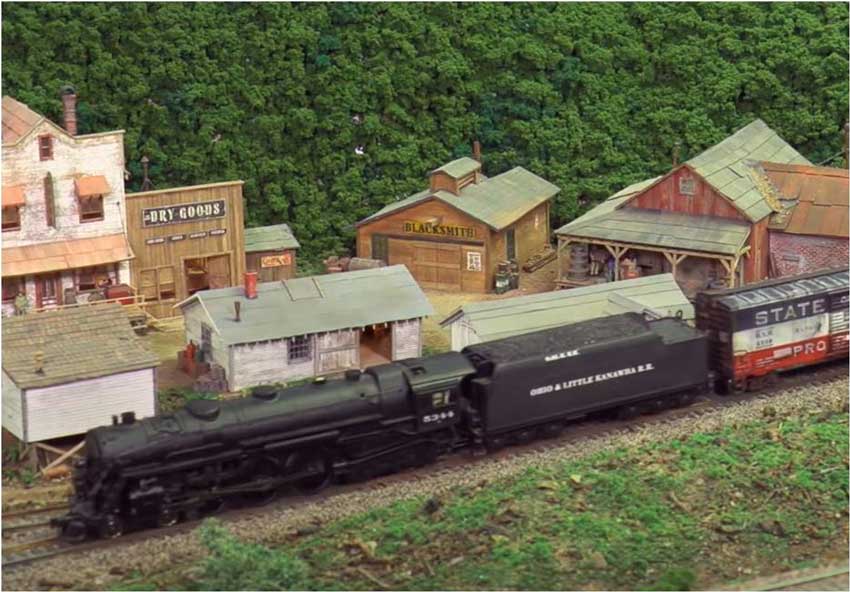 The Ohio & Little Kanawha is eastern US transition railroading at its best! This layout is owned by Ted Stephens, who recently earned his MMR certification from the NMRA. This layout was built for operations, and contains a lot of important layout design concepts that make it perfect for operations.
The Ohio & Little Kanawha is eastern US transition railroading at its best! This layout is owned by Ted Stephens, who recently earned his MMR certification from the NMRA. This layout was built for operations, and contains a lot of important layout design concepts that make it perfect for operations.
With dozens of vignettes, highly detailed scenes, lots of finished and lighted structures, this is one of the most detailed layouts in the San Francisco Bay Area. Also, you won't want to miss the town that's on a huge stretch of hinged scenery! Join us for a look at the O&LK Railroad with Ted Stephens and Earl Girbovan.
Featured in February 2021 issue of NMRA Magazine.
More photos and information on the BayRails website.
Back to QwikLinks| Tom Swearingen | HO |
| Cal Pacific ‡ | |
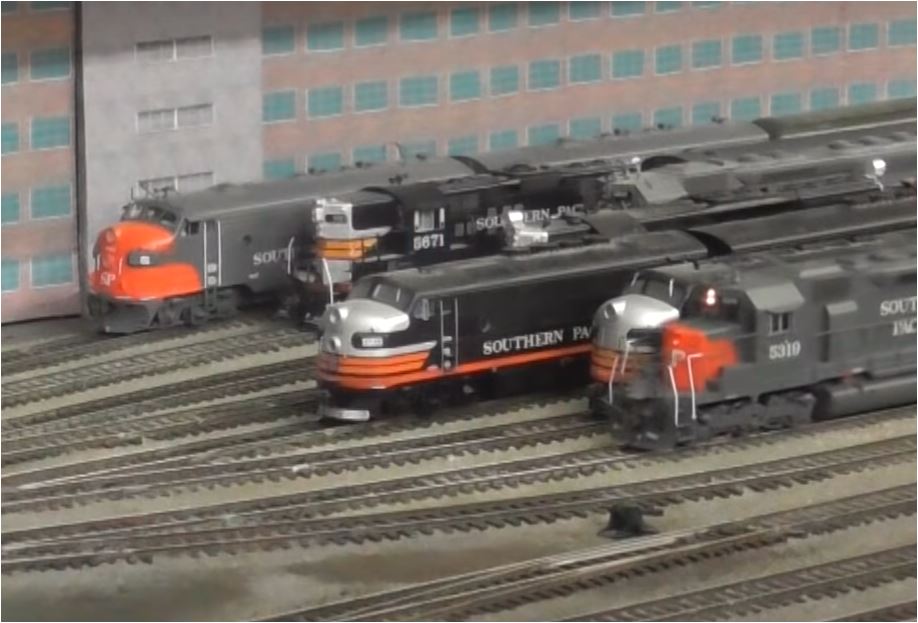 The Cal Pacific is a point-to-point deck layout, running around the perimeter of a two-car detached garage. Operations are conducted by Time Table and a “Mother, may I?” dispatcher, with the addition of train orders coming in the future. Passenger and freight trains move between San Francisco (a bit of modeling license here) and Sacramento, as well as six local turns.
The Cal Pacific is a point-to-point deck layout, running around the perimeter of a two-car detached garage. Operations are conducted by Time Table and a “Mother, may I?” dispatcher, with the addition of train orders coming in the future. Passenger and freight trains move between San Francisco (a bit of modeling license here) and Sacramento, as well as six local turns.
The layout models the cities of Oakland, Emeryville, Berkeley, Richmond, Pinole, Crockett, Martinez, and Sacramento. However, the addition of scenery is in the early stages. Eastbound trains originate from open staging in San Francisco and immediately enter Oakland yard. Then they travel the length of the layout to Ozol Yard and then to open staging in Sacramento. Westbound trains originate in Sacramento and immediately enter Ozol Yard before moving on to Oakland and San Francisco staging. Travel also includes a helix, which is open with some added scenery.
Passenger trains operate under the October 1967 Time Table. The emphasis of my operational layout has been on providing a fun and relaxed atmosphere for friends to run trains while giving me an excuse for building large models. Mistakes actually make the session a bit more fun.
‡ Video used with permission of Model Railroad Operations.
Back to QwikLinks| Tony Thompson | HO |
| SP Santa Rosalia Branch | |
| LDSIG Recommended Layout | |
Layout Owner Panel • Friday, 7:00 – 8:00 PM • Zephyr Track
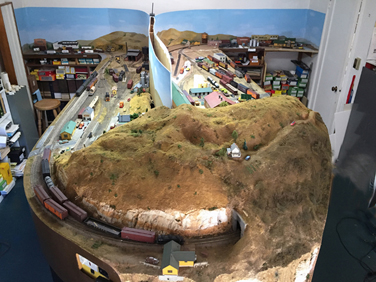 The layout is set in the Central Coast area of California in 1953 and represents a mythical branch line. The branch is primarily a switching challenge and hosts numerous industries typical of the area and era.
The layout is set in the Central Coast area of California in 1953 and represents a mythical branch line. The branch is primarily a switching challenge and hosts numerous industries typical of the area and era.
The layout is T-shaped, with both legs of the Tee about 15 feet in length. The town of Shumala is the junction of the branch with SP’s main line of the Coast Route. An intermediate town on the branch is Ballard, and at the seaside, the branch ends at Santa Rosalia (rose-uh-LEE-uh). Nearly all track is installed, most structures are in place, and about 80 percent of scenery is complete.
Locomotives are a mixture of steam and diesel, all with DCC and sound, and control is via NCE wireless throttles. Most turnouts on the layout are hand-thrown. There is no clock, and crews simply work to complete the switching needs of the area they are working.
Freight cars are a particular interest here, so most cars operating on the layout are models of specific cars and prototypes for the era. Special interest attaches to both refrigerator cars and tank cars, and usually, there are a fair number of both car types in any particular session.
A prototype-inspired waybill system has been devised for the layout, which has been described as it evolved in Railroad Model Craftsman, in December 2009, The Dispatcher's Office (OpSIG's magazine), in April 2010, October 2011, and October 2016, and in Model Railroad Hobbyist (May 2012). Considerable discussion of the development and use of these waybills has been written up in Tony's blog, Modeling the SP, which can be found at modelingthesp.blogspot.com.
Normal operating patterns employ two two-person crews to work on each side of the layout. The timetable contains maps of each town. A mainline local also operates, to pick up and set out the branch line's cars at the junction.
More photos and information on the BayRails website.
Back to QwikLinks| Tri-City Society of Model Engineers | HO/N |
| HO Scale Layout N Scale Layout |
|
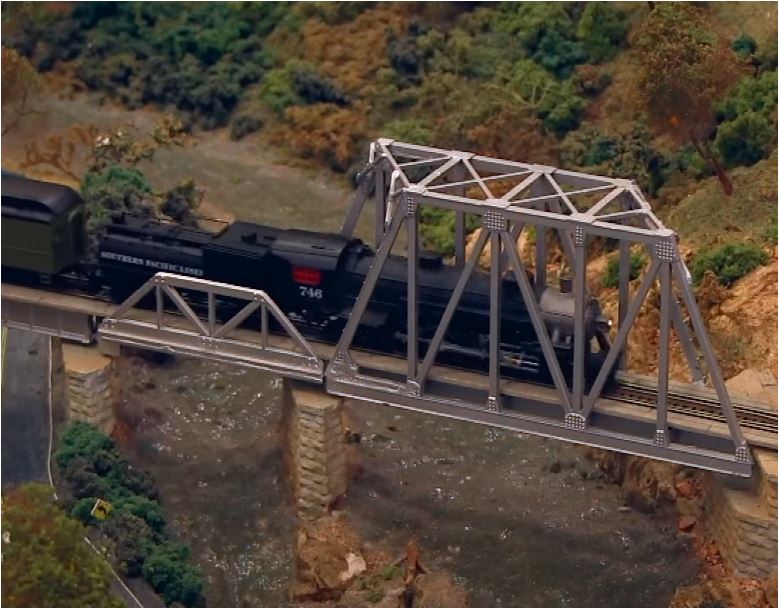 The Niles Passenger and Freight Depots, located in the Niles District of Fremont, California, are home to a railroad museum and two all-new model railroad layouts, which are currently under construction.The layouts are based in Niles and the surrounding communities of the Bay Area. Attention is being given to accuracy and detail in both the track plans and surrounding scenery. The modeling era is the mid-1970s, but all industries and towns are being represented as they were in their prime.
The Niles Passenger and Freight Depots, located in the Niles District of Fremont, California, are home to a railroad museum and two all-new model railroad layouts, which are currently under construction.The layouts are based in Niles and the surrounding communities of the Bay Area. Attention is being given to accuracy and detail in both the track plans and surrounding scenery. The modeling era is the mid-1970s, but all industries and towns are being represented as they were in their prime.
The 2,000 square foot HO scale layout features the Southern Pacific mainline from Niles to San Jose with the many industries in Niles, Newark, Union City, and other intermediate communities, as well as both Southern Pacific and Western Pacific lines through Niles Canyon to Pleasanton and Livermore. San Jose Cahill Street Station is featured as the model railroad’s large passenger terminal. A section will also feature the BART line through Fremont.
The N scale layout features the SP and WP mainlines from Niles to Oakland with intermediate communities such as Decoto, Alvarado, and Hayward.
Website: http://www.nilesdepot.org/niles/modelrailroads.html
Back to QwikLinks| Ray Turner | Gn3 |
| Mystic Mountain Railroad | |
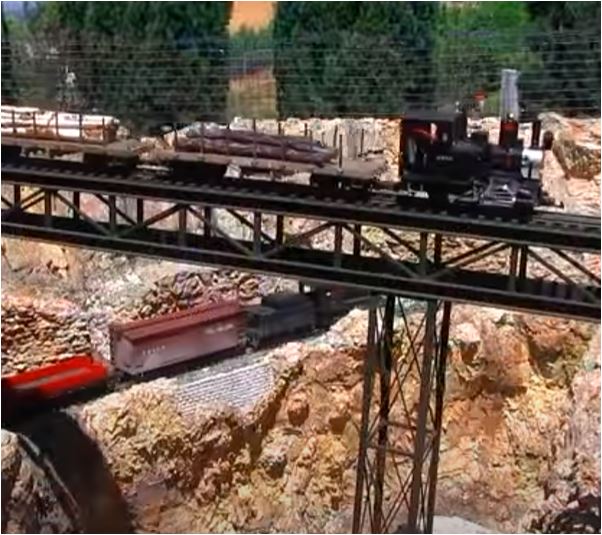 The Mystic Mountain Railroad is a backcountry short line, loosely set in the early 1900s, consisting of 1200’ of code 250 nickel silver track. The railroad can be run as a single large loop or two smaller loops, with several passing sidings. There are two small yards, 22 spurs, two wyes for turning trains, and many tunnels and bridges. The Mountain Division runs over rugged mountains and deep canyons, necessitating many steel bridges, tunnels, and a large helix.
The Mystic Mountain Railroad is a backcountry short line, loosely set in the early 1900s, consisting of 1200’ of code 250 nickel silver track. The railroad can be run as a single large loop or two smaller loops, with several passing sidings. There are two small yards, 22 spurs, two wyes for turning trains, and many tunnels and bridges. The Mountain Division runs over rugged mountains and deep canyons, necessitating many steel bridges, tunnels, and a large helix.
A scratch-built turntable/roundhouse facility is located at the North End yard in the Mountain Division. Trains can also be run point-to-point between the two yards for realistic operating sessions. Trains are battery-powered radio-controlled using Revolution and Train Engineer with SoundTraxx sound systems.
The most recent additions are the 5˝’ long Global Wizard Mfg. (G-Wiz), the sawmill complex, the Acme manufacturing plant (“Everything for the wily coyote”), and the wharf and Mercury Cannery Co. at North End. The scratch-built 4M Mining Company (“One better than 3M”) is cast concrete and weighs 120 lbs. One unique feature is the use of concrete rock wall castings painted with acrylics.
A panoramic view of Silicon Valley serves as a natural “backdrop” to the railroad. Another unique feature is a 4-way pointless/frogless turnout for access to train storage. A separate whimsical fairy garden with its own Fairy Train will also be on display. Both railroads are lit for night time operation.
Website: www.mysticmountainarts.com/MMRR/
Back to QwikLinks| Paul Weiss | HO |
| Central Vermont Railway | |
| LDSIG Recommended Layout | |
Layout Owner Panel • Tuesday, 8:00 – 9:00 PM • Zephyr Track
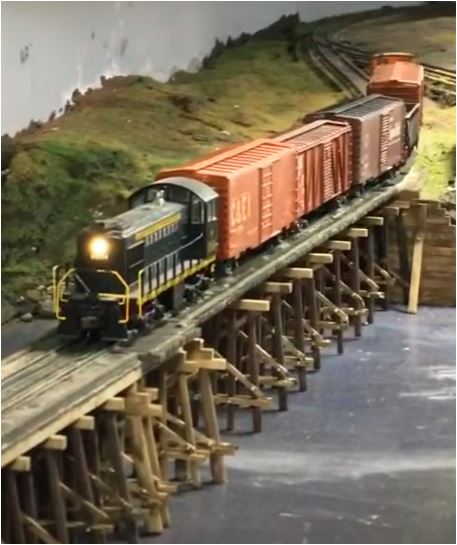 The CVRR in Northern California project began when a building for this purpose was acquired in 2016. The vintage building was originally a kerosene dealer served by the Northwestern Pacific Railroad and (while its spur is gone) it sits alongside the right of way which now also hosts SMART commuter rail service. The building is slightly more than 30' x 40' and is entirely dedicated to building an operations-based model railroad, using the Central Vermont Southern Division as a prototype, circa 1956.
The CVRR in Northern California project began when a building for this purpose was acquired in 2016. The vintage building was originally a kerosene dealer served by the Northwestern Pacific Railroad and (while its spur is gone) it sits alongside the right of way which now also hosts SMART commuter rail service. The building is slightly more than 30' x 40' and is entirely dedicated to building an operations-based model railroad, using the Central Vermont Southern Division as a prototype, circa 1956.
To take advantage of the building’s interior ceiling height of more than 12 feet, we designed a double-deck layout and raised the layout, and operator aisles by approximately 3 feet. The result is that the benchwork is a normal height for operators standing in the elevated aisle but 6 feet above the floor of the building, allowing us to put full-height access aisles and comfortable agent offices under the layout itself.
The around-the-wall helix scheme allows approximately 650 feet of mainline. Our biggest yard in East New London, Connecticut, is approximately 80 feet total length. We greatly emphasized design features to maximize operator comforts, such as no bottlenecks in the aisles and no duckunders anywhere. Visitors enter under the full height mainline span and then step comfortably up to the operating aisles.
The CVRR Southern Division ran from New London, CT, a busy port city, northward to rural Connecticut and then across the state line to Massachusetts. The prototype continued to Vermont and connected to the parent company Canadian National at the international border. We have included most of the important towns along the line in Connecticut and on into Massachusetts; our last major town is Palmer, MA, where the line interchanges with the Boston and Albany mainline between New York and Boston. The railroad is operationally interesting, as there is a great deal of local switching and some hot trains, including daily newsprint trains from Canada for newspapers in the Northeast.
We chose to model 1956 as steam was still alive on the CV at that time. Also, the area has compelling scenic beauty as it gets more rural heading northward, but will also boast the dynamic port and urban scenes at the southern end.
We are building toward being able to enjoy large TT&TO operating sessions staffed by 12-15 operators and staffers. We are emphasizing very high reliability and craftsmanship.
Featured in the January 2021 issue of NMRA Magazine.
Website: www.cvrailroad.com
More photos and information on the BayRails website.
Back to QwikLinks| Nick Wright | F / Fn3 |
| Wright Railway | |
 In this layout tour, Nick Wright shows us his garden railroad, talks about its history, tells us about his modeling inspiration for what he does, and demonstrates that it's easy to have fun even if your layout isn't the biggest or most complex! He also shows how he laid his trackwork to minimize settling and how he ensures electrical reliability in the challenging outdoor environment. Join us for a look at the Wright Railway!
In this layout tour, Nick Wright shows us his garden railroad, talks about its history, tells us about his modeling inspiration for what he does, and demonstrates that it's easy to have fun even if your layout isn't the biggest or most complex! He also shows how he laid his trackwork to minimize settling and how he ensures electrical reliability in the challenging outdoor environment. Join us for a look at the Wright Railway!
| John Zach | HO |
| Sierra Railroad | |
| LDSIG Recommended Layout | |
Layout Owner Panel • Tuesday, 8:00 – 9:00 PM • Zephyr Track
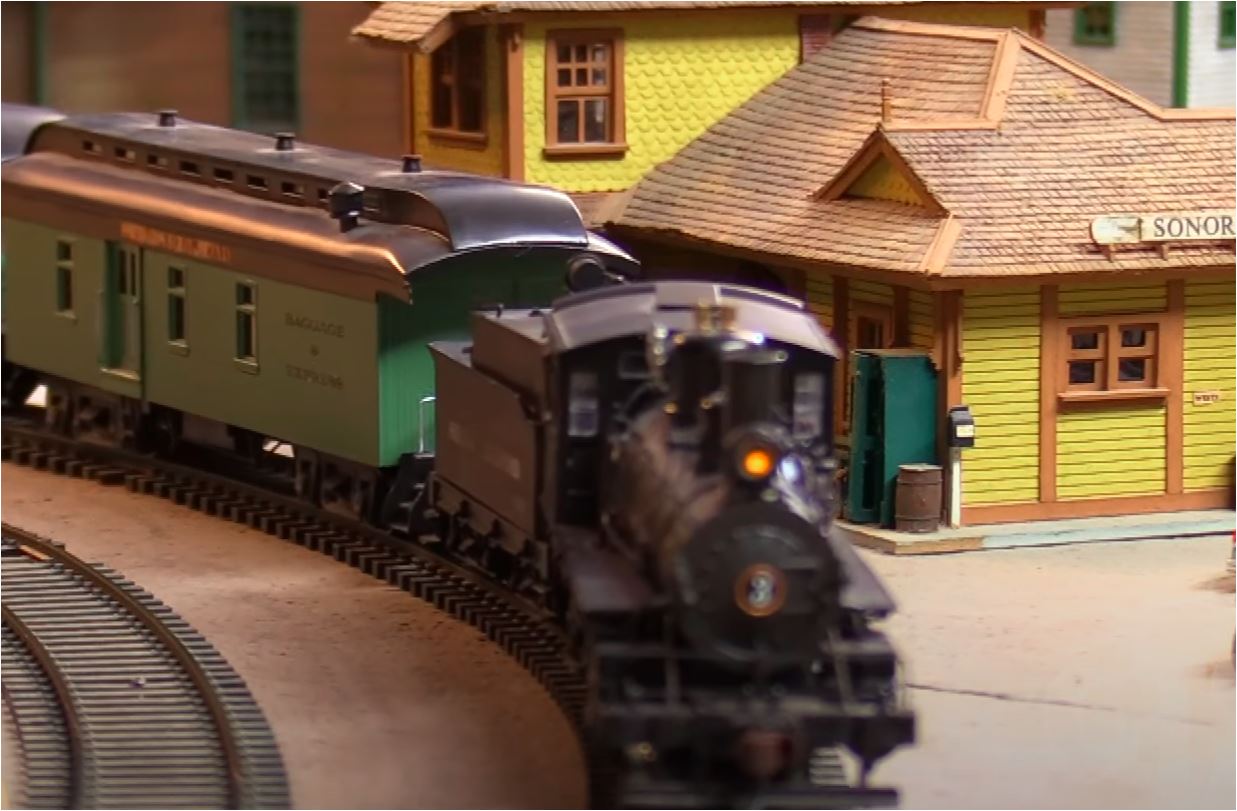 This HO scale model railroad is based on the Sierra Railroad that started its long and glorious history in 1897 and is still in operation today. The time frame for the layout is the Spring of 1955 when the first diesel locomotives (Baldwin S-12s) arrive on the railroad and the logging railroads of the Pickering and West Side Lumber Company were still going strong.
This HO scale model railroad is based on the Sierra Railroad that started its long and glorious history in 1897 and is still in operation today. The time frame for the layout is the Spring of 1955 when the first diesel locomotives (Baldwin S-12s) arrive on the railroad and the logging railroads of the Pickering and West Side Lumber Company were still going strong.
The layout is situated in a 1,500 square foot basement and from the SP Depot in Oakdale to the Sierra Depot in Tuolumne the Sierra mainline is 10.5 scale miles long. The trains are controlled by CVP’s EasyDCC with 8 tethered throttles and 8 radio throttles. The majority of the track is Walther’s Code 83 track and turnouts with Code 70 track used on the logging lines. Except for about 9 Tortoise Switch Machines, all turnouts are Caboose Industries ground throws.
In addition to the logging railroads, the Hetch Hetchy Railroad is represented at Hetch Hetchy Jct with its wye and its mainline heading off to Groveland and a staging track. Running through Oakdale is the SP Eastside Branch running from Stockton south through Oakdale to Merced. Stockton and Merced are the major staging yards of the layout that feeds cars to the Sierra and receives cars from the Sierra. Also running into Oakdale is the AT&SF branch from Riverbank, which also feeds cars to the Sierra and receives cars from the Sierra.
More photos and information on the BayRails website.
Website: www.sierrarailroad55.com
Back to QwikLinksLayout Tour Videos, except when noted otherwise, used with permission of John Abatecola, TSG Multimedia. Thank you!
Paul Deis
Layout Tours Coordinator
This page last updated:
